What your state looked like in the 1980s
Living it large in the 1980s
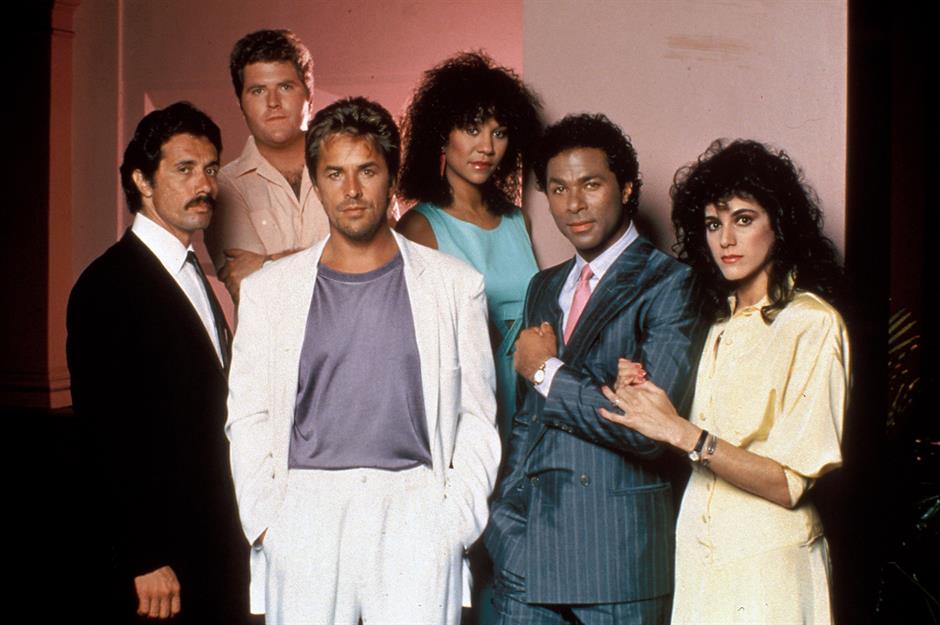
The 1980s are regarded as a turning point in US history with the emergence of political conservatism and new technologies. But for most part, Americans simply went on living their lives, albeit with bigger hair and a few more pastel colors in their wardrobe.
Click through the gallery to see what your state looked like in the 1980s and the difference 40-odd years makes…
Alabama: Rural grocery store (1980)
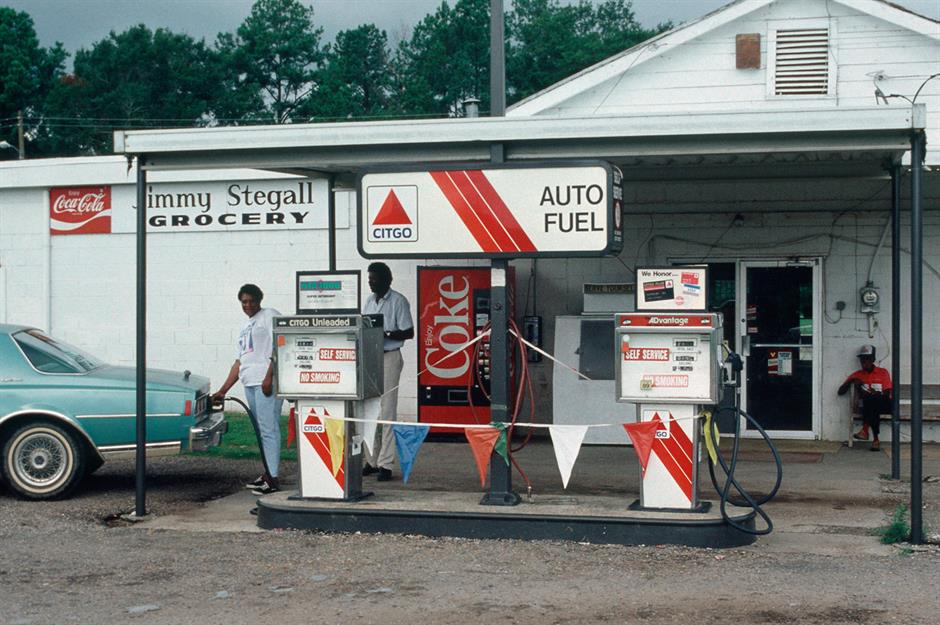
It’s the first year of the new decade and these locals at a rural grocery store in Emelle, Alabama are in for a shock. The Iranian Revolution in 1979 sent shockwaves through global oil markets, and by the time the Iran-Iraq War began in late 1980, gas prices had soared.
At the end of 1978, a gallon of gas in the US cost around $0.65. By 1980, that same gallon averaged $1.22 – nearly double the price in just two years. Adjusted for inflation, that’s about $4.70 today.
Alaska: Kodiak Crab Festival Parade (1982)
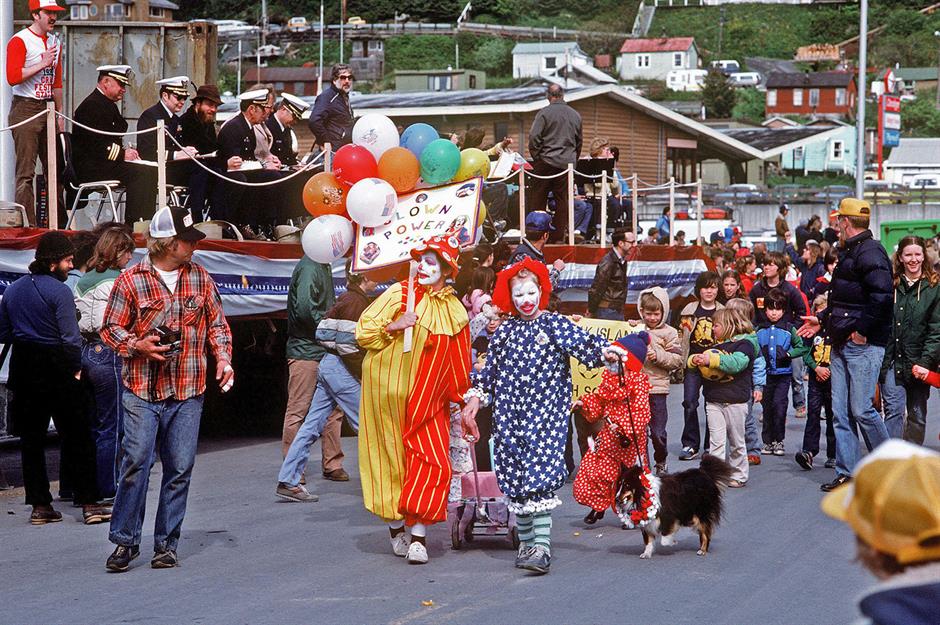
This colorful festival has been held in the city of Kodiak on Kodiak island, Alaska since 1958. The five-day event begins with the suitably eccentric Crab Fest Parade (pictured) and ends on Memorial Day with a blessing of the local fishing fleet.
Kodiak Island was famously home to the Kodiak Naval Operating Base, a vital facility during World War II. Here we see officers from the ammunition ship USS PYRO judging the parade in 1982.
Arizona: Western dinner in Scottsdale (1985)
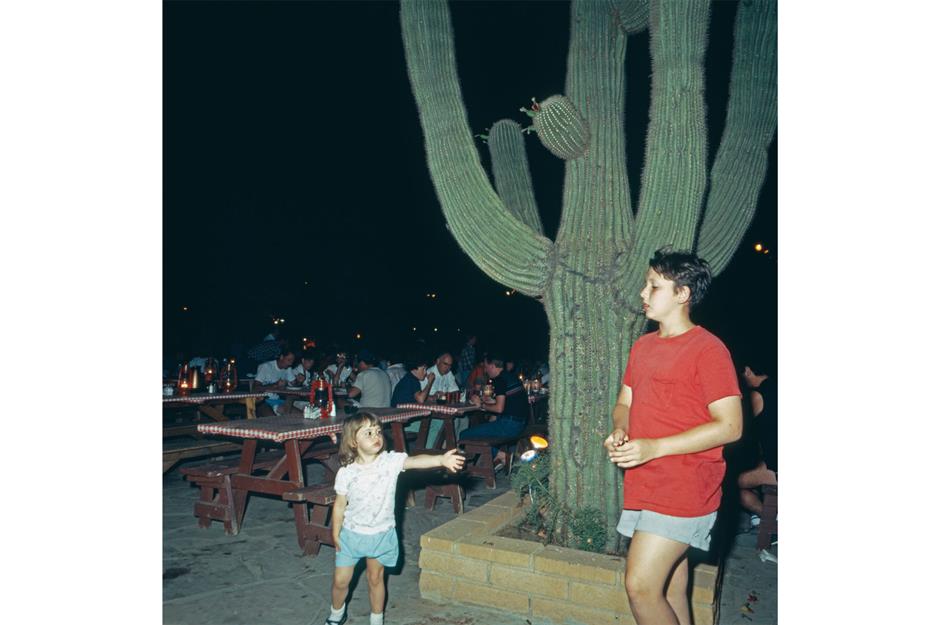
German photographer Walter Rudolph snapped this photo in 1985 as he traveled the US capturing everyday life – here, a brother and sister play near a saguaro cactus at a Western-themed restaurant in Scottsdale.
Restaurants that leaned into the romance of the Wild West were popular in Arizona in the 1980s, particularly Scottsdale’s Pinnacle Peak Patio where diners were served a cowboy boot if they ordered their steak well done.
Arkansas: Dog Patch billboard, east of Harrison (1980)
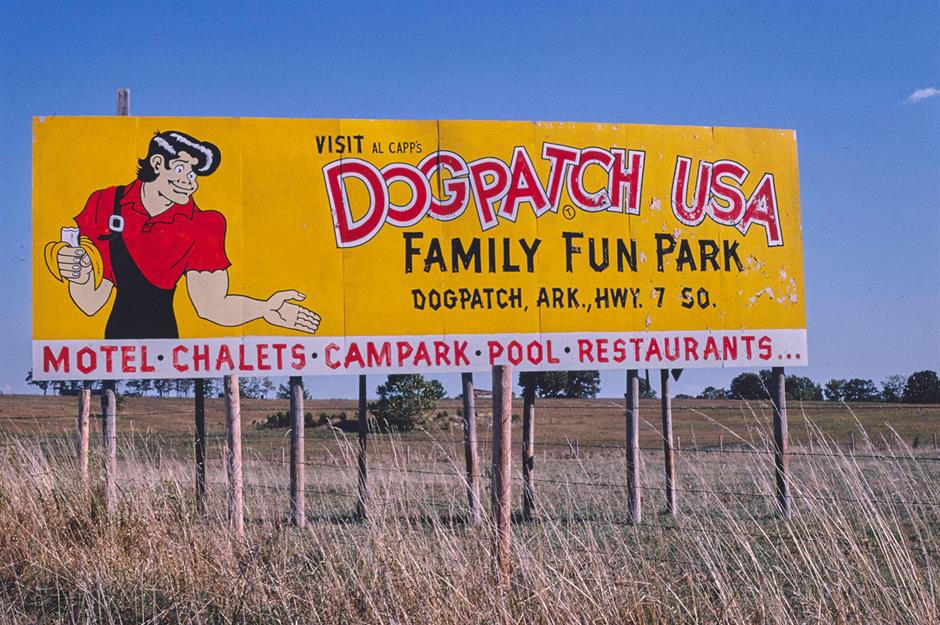
Dogpatch USA was a theme park near Marble Falls in northwest Arkansas, based on the characters from Al Capp’s popular comic strip, Li'l Abner. It featured a trout farm, an apiary, Ozark arts and crafts, and entertainment featuring characters from the Strip.
The park opened in 1968 and was so successful that Marble Falls changed its name to Dogpatch in order to cash in. The park closed in 1993, and in 1997 the town quietly changed its name back.
Love this? Follow our Facebook page for more travel inspiration
California: Tower Records, Sunset Strip, Los Angeles (1988)
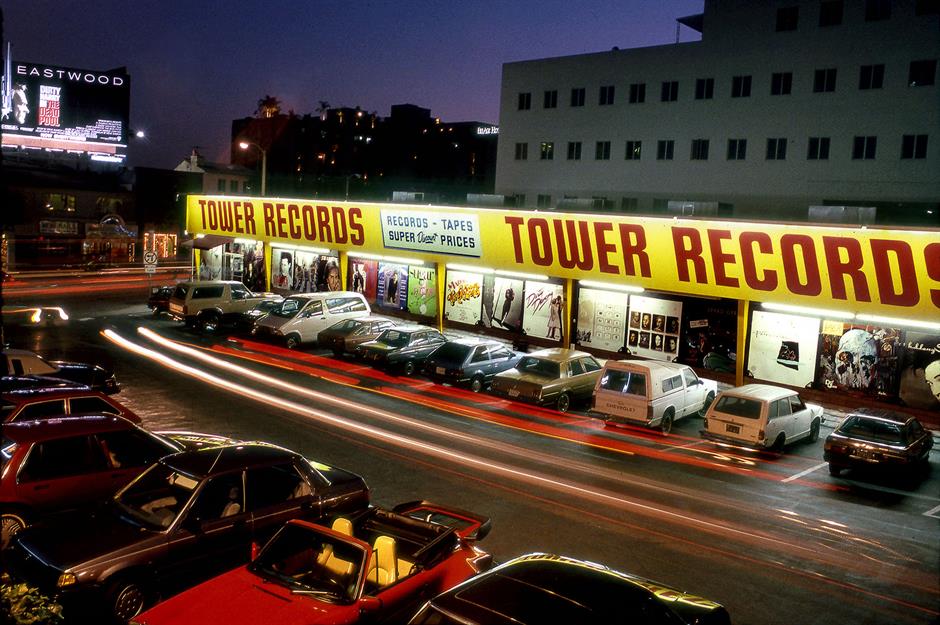
In the 1980s Tower Records was a mecca for music lovers, fueled by the release of career-defining albums from artists like Bruce Springsteen, Michael Jackson, and Madonna, and the introduction of the crystal-clear sound of CDs.
Here we see Tower Records' flagship store on Sunset Strip in Los Angeles in 1988. The store was famously a regular haunt of Elton John – who’d visit every Tuesday to stock up on all the latest releases.
Colorado: Youth camp at ranch (1987)
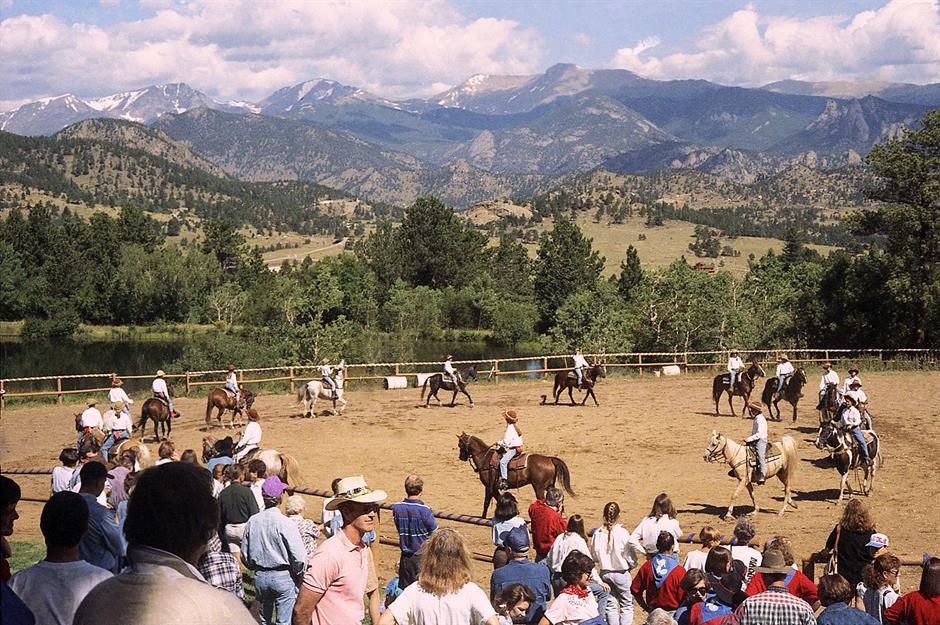
Summer camps in the US are a popular and well-established tradition where children between six and 16 are shipped off for summer vacation to blow off some steam, and enjoy a wide range of activities.
In the 1980s, the youth of Colorado could attend summer ranches, like this one pictured in 1987. Here they learned the fundamentals of equestrianism covering a range of grooming, riding, training, showing, health, and nutrition.
Connecticut: Canine rest area (1980)
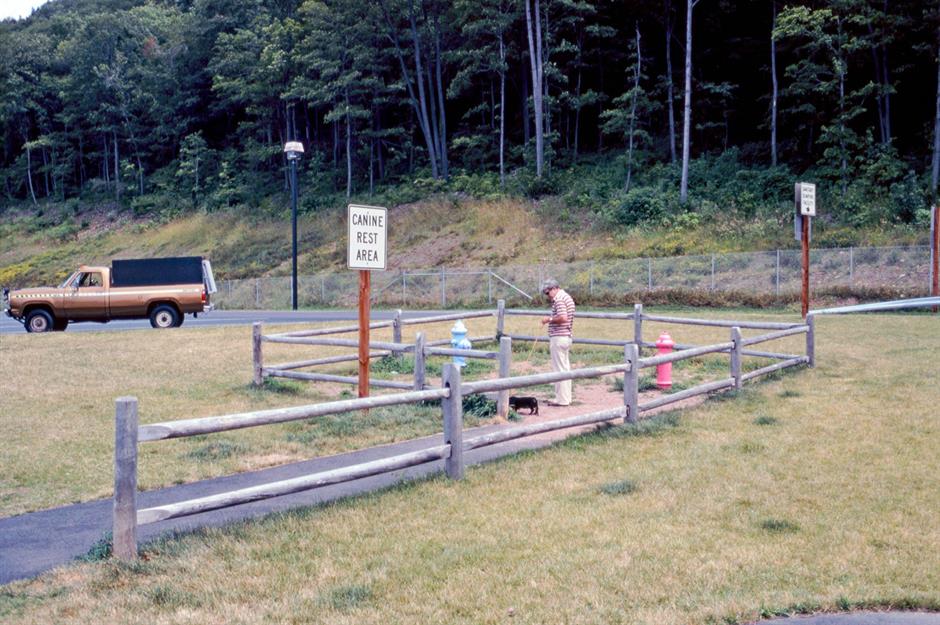
Roadside rest stops have been a feature of American highways since the 1950s. Most are simple and basic, offering little more than a parking space, a toilet, and maybe a picnic table or two.
Sometime in the 1980s, as we can see from this photo taken in Connecticut, they began offering something more. A rest stop for canine passengers, complete with old fire hydrants to act as encouragement.
Delaware: Sir Goony Golf, Rehoboth Beach (1985)

They say there’s nothing new under the sun – a saying that rings especially true for American mini golf in the 1980s. Sir Goony Golf was founded in 1962 by Dutch McGrath in Chattanooga, Tennessee, inspired by the Goofy Golf courses that had taken root in Florida.
Known for surreal and varied themes – from dinosaurs and pirates to space aliens – the franchise expanded across the US, with 36 locations by the mid-1980s, including this one at Rehoboth Beach in Delaware.
Florida: Miami Vice (1984)
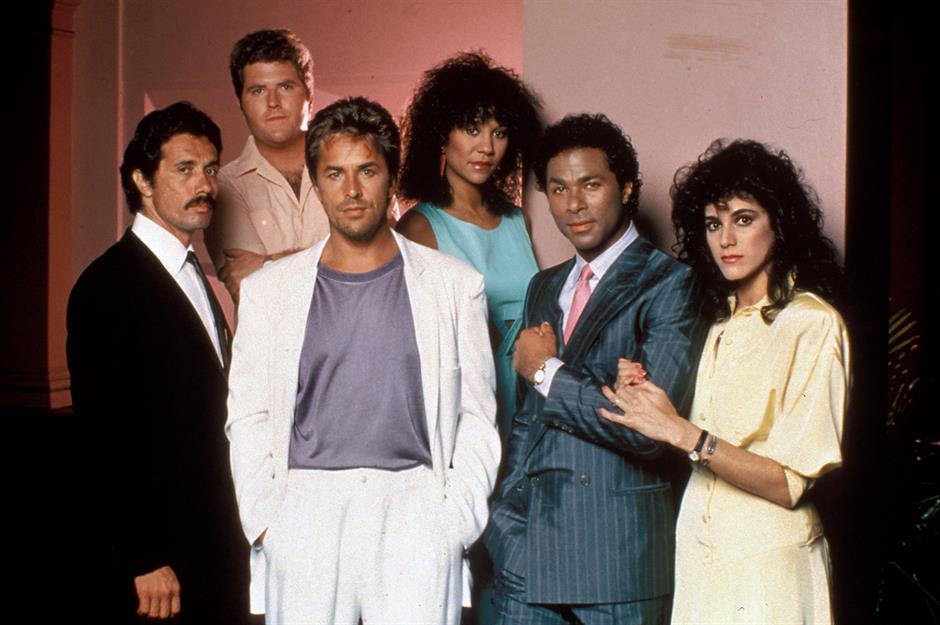
Resplendent with period music, fashion, and ‘vibe’, 1980s TV detective series Miami Vice has since become shorthand for the decade. Pastel-colored suits and shoes without socks? Check. Open-top sports cars and beaches lined with soaring condos? Again, check.
Crockett, played by Don Johnson, and Tubbs, played by Philip Michael Thomas, were quite literally the face of the 1980s. And the show’s synth-laden theme song, written and performed by Jan Hammer, its irresistible soundtrack.
Georgia: Tourists in Savannah (1983)
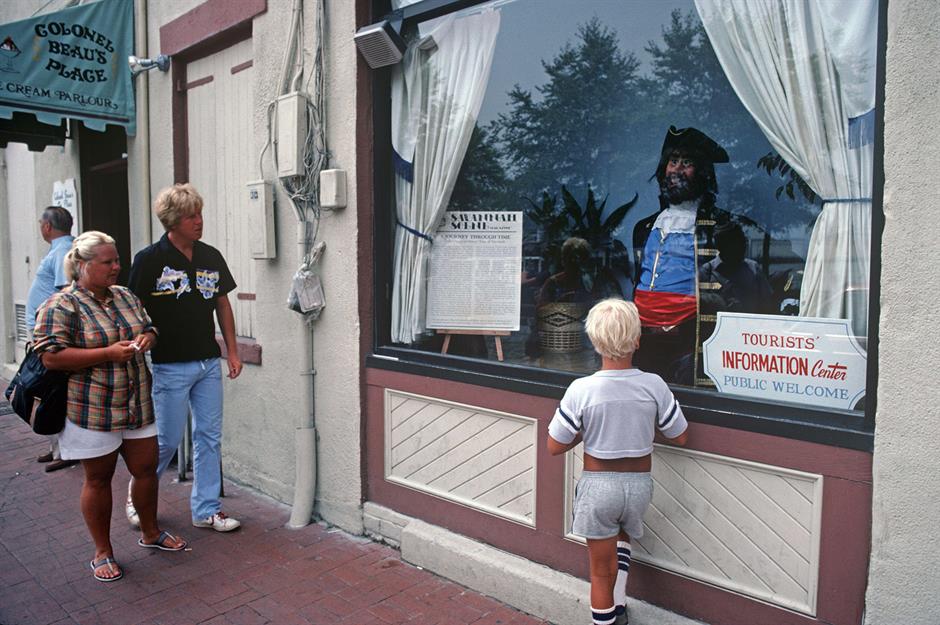
The year 1983 marked the 250th anniversary of the founding of Savannah, the oldest city in Georgia and a real southern charmer. Visitors, like these pictured, flocked to the city to discover its rich history, colonial period architecture, and vibrant culture.
The city leaned into its pirate history too, particularly the tale of the infamous Captain Kidd, and the treasure that legend says he buried on nearby Tybee Island.
Hawaii: Kapalua Beach (1986)
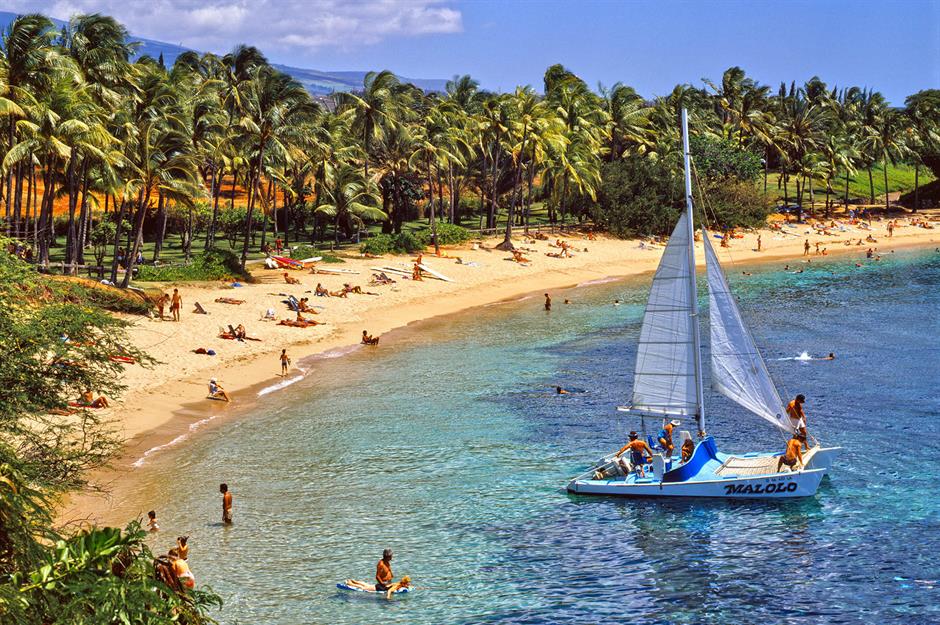
Palm-fringed Kapalua Beach on the Hawaiian island of Maui regularly features in ‘World’s Best Beaches’ lists, and it’s not hard to see why. This stunning golden crescent is picture perfect, with great snorkeling just offshore to boot.
Things have changed since this picture was taken in 1986. Not so much the beach, which remains resolutely gorgeous. Rather the 24-acre luxury Montage resort directly behind it, renovated in 2014 to bring unmatched levels of sophistication to the spot.
Idaho: Chief Theater, Pocatello (1980)
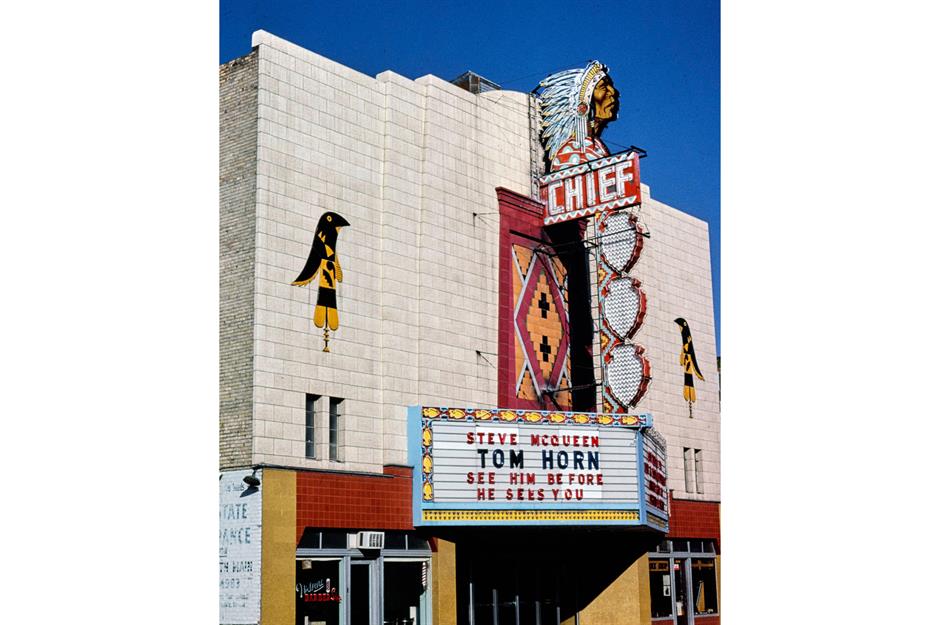
Here we see Pocatello’s iconic Chief Theater, opened in 1932 and destroyed by a fire in 1993. The movie showing starred Steve McQueen as the legendary outlaw Tom Horn, and was one of the last films he made.
The interior of the theater was stenciled with Wild West motifs, and the neon-lit head of an Indian chief atop the entrance was a Main Street landmark. Today the spot is an unassuming vacant block, used as a parking lot.
Illinois: Great America Theme Park, Gurnee (1985)
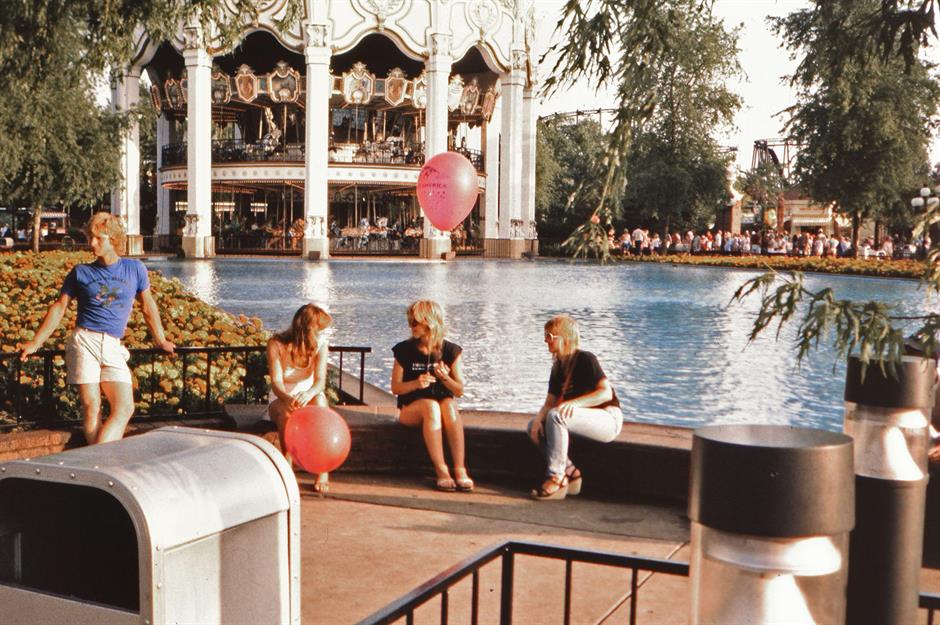
In 1976, the Marriott hotel chain dipped its toes into the world of theme parks, opening its ‘Great America’ parks in Santa Clara, California, and Gurnee, Illinois, a site chosen because of its proximity to Chicago.
Here we see teens catching their breath after a long day riding the park’s famous roller coasters in 1985. The park had been acquired by Six Flags just the year before, who also secured the right to use iconic Looney Tunes characters across all its properties.
Indiana: Indiana State Capitol (1987)
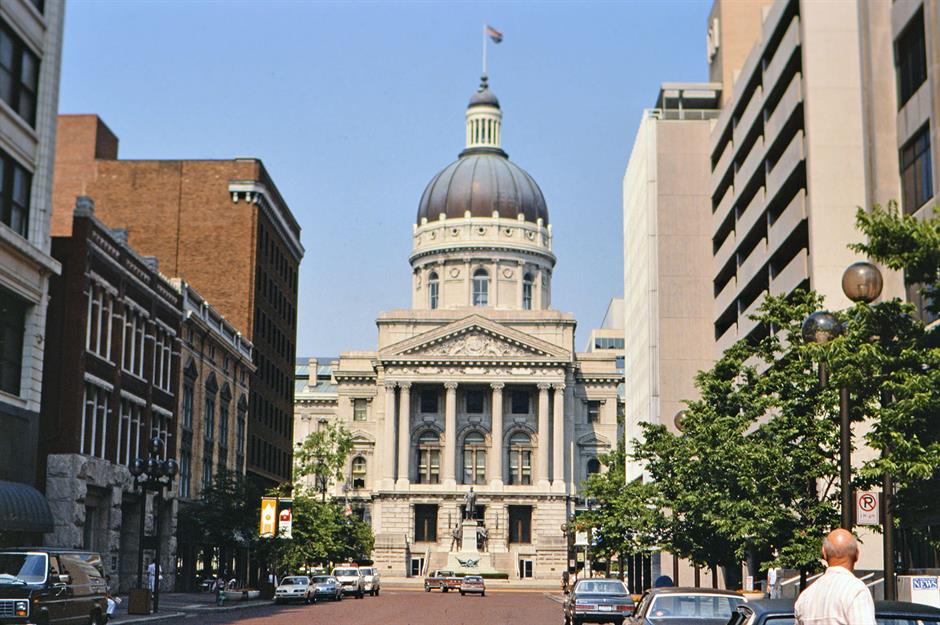
Here we see the Indiana State Capitol in downtown Indianapolis, just a year before its centennial in 1988. As part of the celebrations, the building underwent extensive renovations to restore its original grandeur.
Artisans recreated handcrafted door moldings and other trim, stripped away wallpaper to reveal the original hand-stenciling on the walls, and resheathed the exterior of the building’s iconic dome in copper.
Iowa: Pocahontas Gift Shop, Pocahontas (1987)
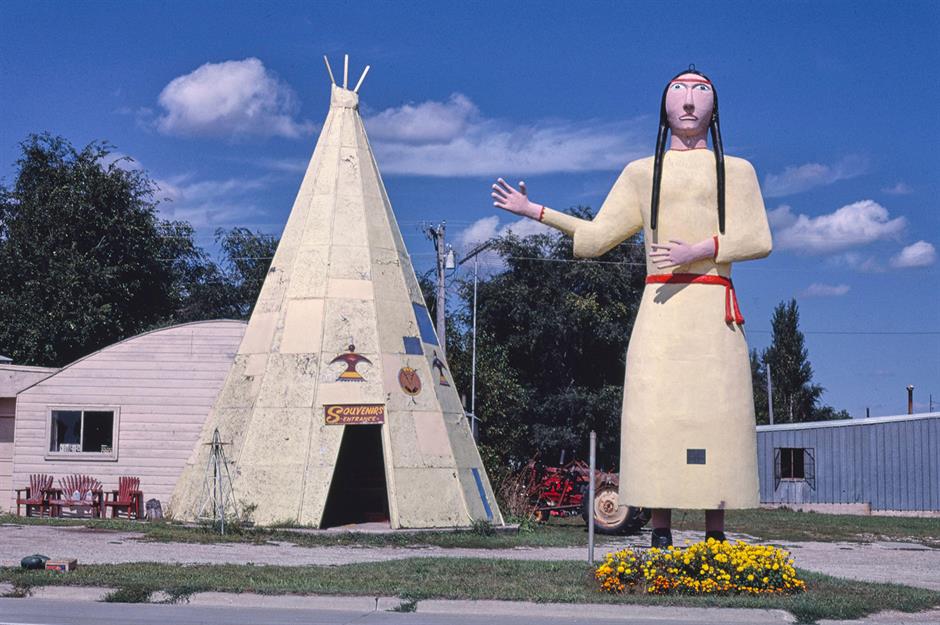
This 25-foot likeness of Pocahontas was built in 1956 and is regarded as the ‘architectural glory’ of Pocahontas, Iowa. It was designed by W.C. Ballard, the man also responsible for the statue of Paul Bunyan's sweetheart in Minnesota, and is recognized as the largest Indian maiden monument in the world.
When this photo was taken in 1987, it stood gesturing towards the Miss Pocahontas Souvenir Shop. The shop was torn down in the late 1990s and replaced with a smaller, less stylized teepee in 2014.
Kansas: Matt Dillon (1988)
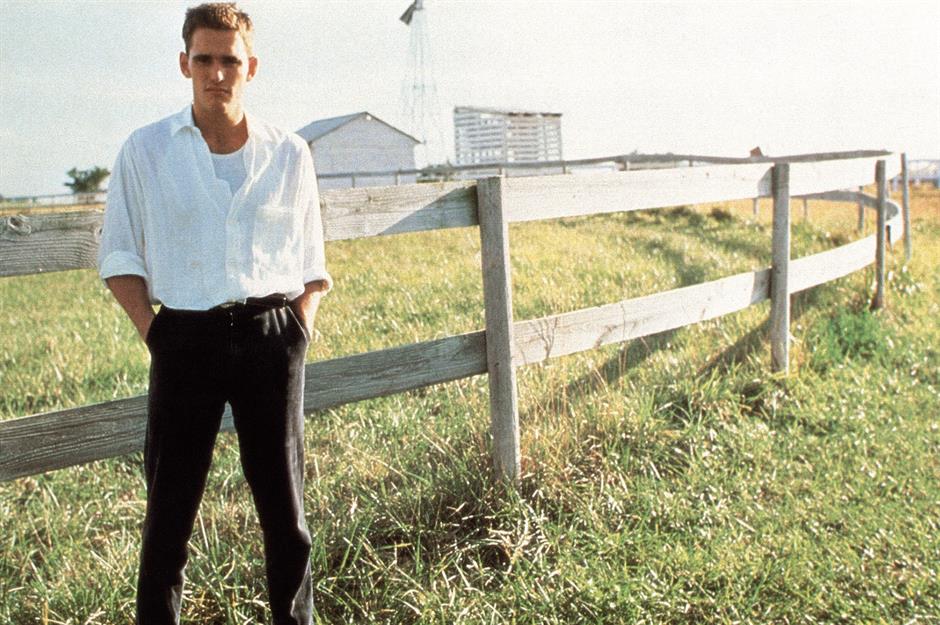
Described by Time Out as an ‘uneven blend of crime thriller and rural romance’ the 1988 movie Kansas, starring Matt Dillon (pictured) and Andrew McCarthy, at least got one thing right – the widescreen beauty of the state it was named after.
The film was shot in a variety of locations including Lawrence, Edgerton, Topeka, and Overbrook – the latter being where the movie’s iconic carnival scene took place.
Kentucky: Bluegrass concert (1984)
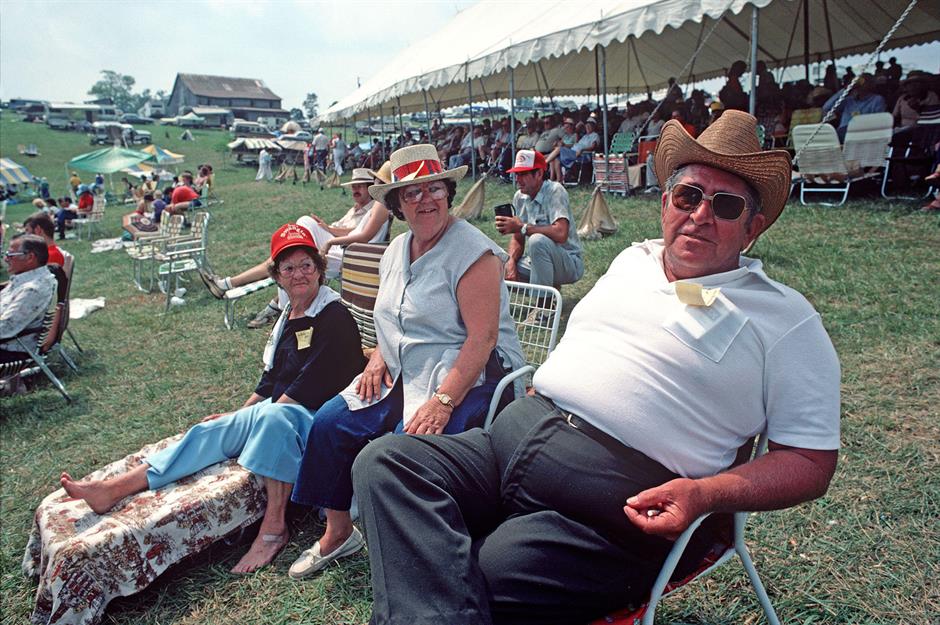
Alain le Garsmeur is regarded as one of the most important photojournalists of his time and in the mid-1980s he turned his eye to the extraordinary and mundane aspects of life in the USA.
In 1984, he found himself in Lexington, taking photos of the area’s fabled horse farms as well as the city’s less affluent corners. He also found himself at an outdoor bluegrass concert where he snapped this evocative image.
Louisiana: Louisiana Expo (1984)
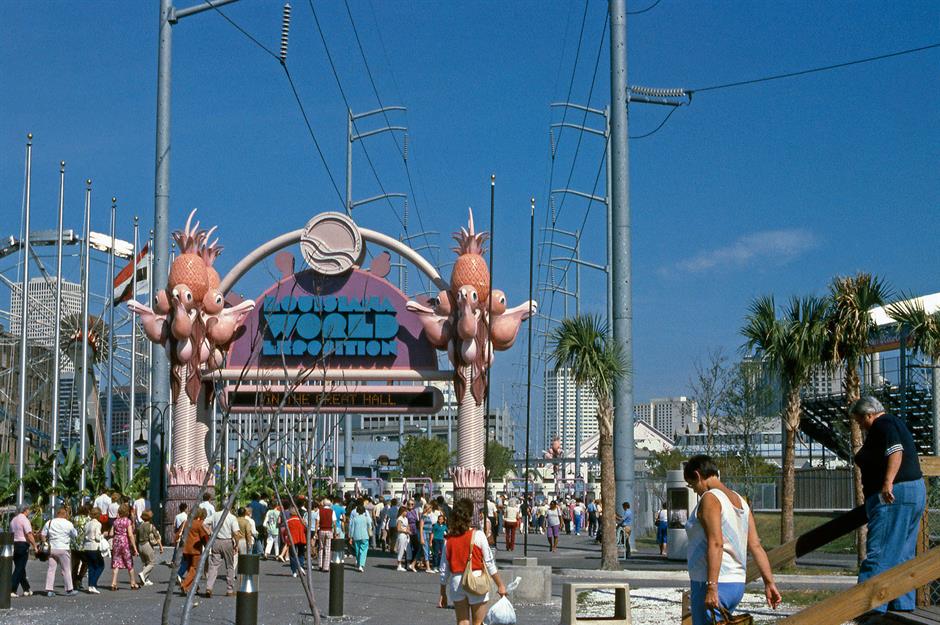
The Louisiana World Exposition, held in New Orleans in 1984, was a momentous event in the city's history, with its prescient theme of 'The World of Rivers' drawing attention to the importance of fresh water in sustaining life.
Here we see a mere handful of the 7.3 million visitors that attended the expo during its six-month run. Like much of the expo, the ornate entrance seen here is long gone, but the event is credited with kickstarting the city’s popular Warehouse District.
Maine: Monhegan Island (c.1980s)
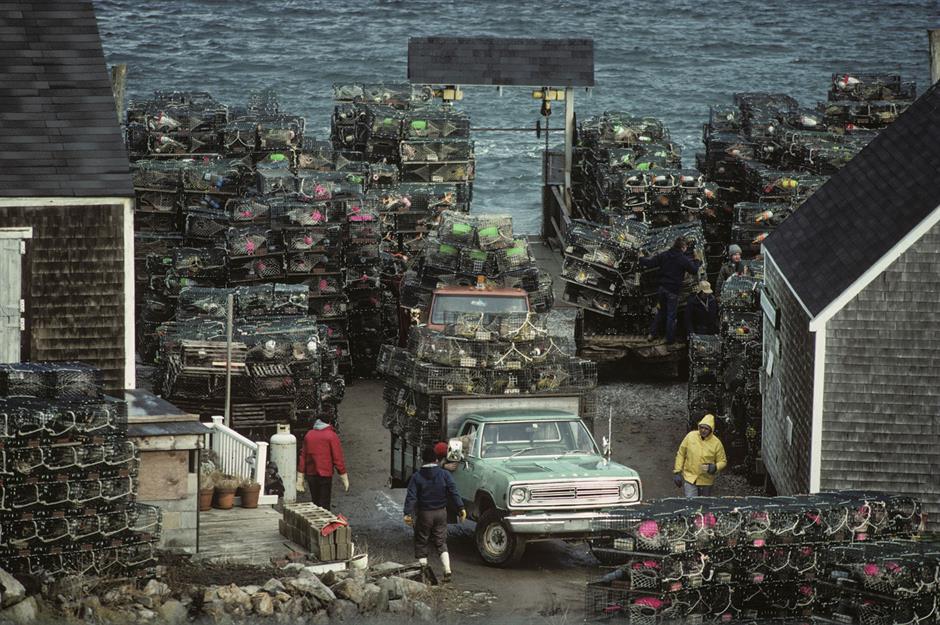
Tiny Monhegan Island sits about 10 miles off mid-coast Maine. In the 1980s, its population barely topped 100, and those who lived there contended with limited electricity from diesel generators and a fickle fishing and tourism economy.
Things got busier each winter, however, when the island’s self-imposed lobster season began on January 1. Designed to preserve lobster populations, this winter-only approach also meant islanders could harvest hard-shelled lobsters that fetched premium prices.
Maryland: Ocean Gallery, Ocean City (1985)

The Ocean Gallery on Ocean City’s boardwalk was created by artist Joe Kro-Art after he arrived on the Maryland coast to sell his art in 1964. Colorful and chaotic, it was rammed with art eccentric as the building that housed it.
When this photo was taken in 1985, the gallery was already a much-loved local landmark. In 2014, there was talk of moving the entire building to Hollywood for a reality TV show, but the plan never materialized – and the Ocean Gallery remains on the boardwalk to this day.
Massachusetts: Cape Cod (1988)
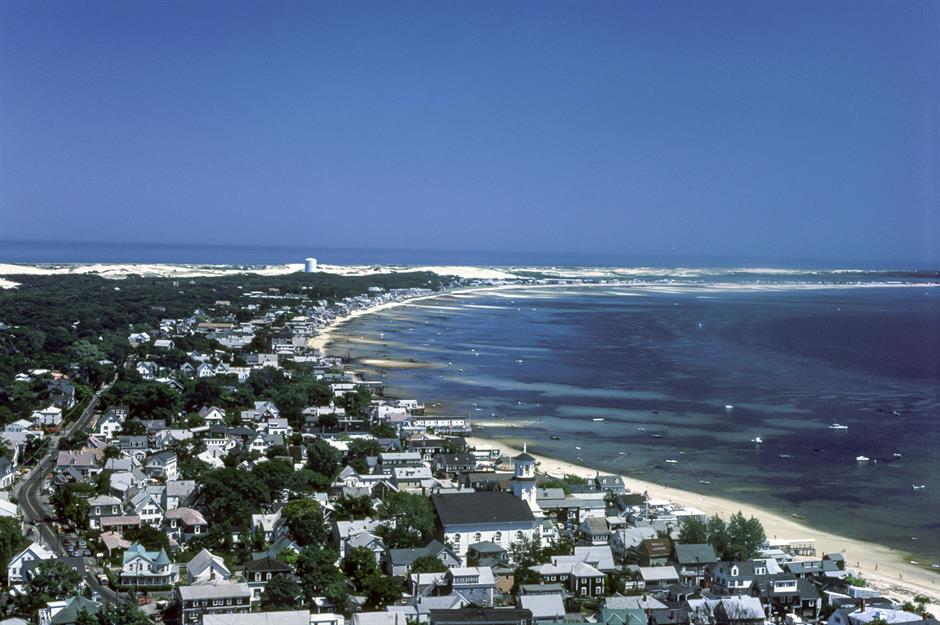
This photo of Provincetown on Cape Cod was taken from the top of the Pilgrim Monument in 1988. And to be honest, if you clambered up the 116 steps and 60 ramps to the top today, you’d discover that very little has changed over the corresponding decades.
The First Universalist Meeting House, built in 1847, is still the most distinctive landmark – after the Pilgrim Monument, of course, which remains the tallest all-granite structure in the United States. Provincetown also remains a magnet for artists and the LGBTQ+ community.
Michigan: Uniroyal tire, Allen Park (1986)
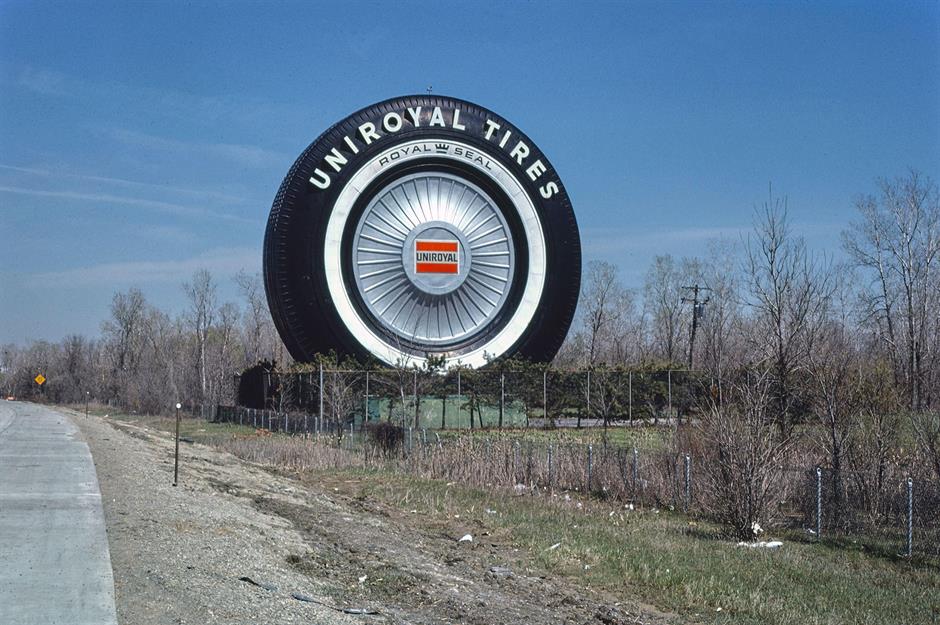
This beloved Detroit landmark has loomed over I-94 since 1966, but it actually began life as a giant Ferris wheel at the 1964–65 New York World’s Fair. It featured 24 gondolas that carried passengers around the tire for the grand sum of 50 cents.
After the fair, it was dismantled and shipped in 118 sections to the Uniroyal sales office in Allen Park, Michigan. When this photo was taken in 1986, the tire had become a local icon – though some had begun taking potshots at it with guns and bows and arrows.
Minnesota: Cathedral of St Paul (1987)
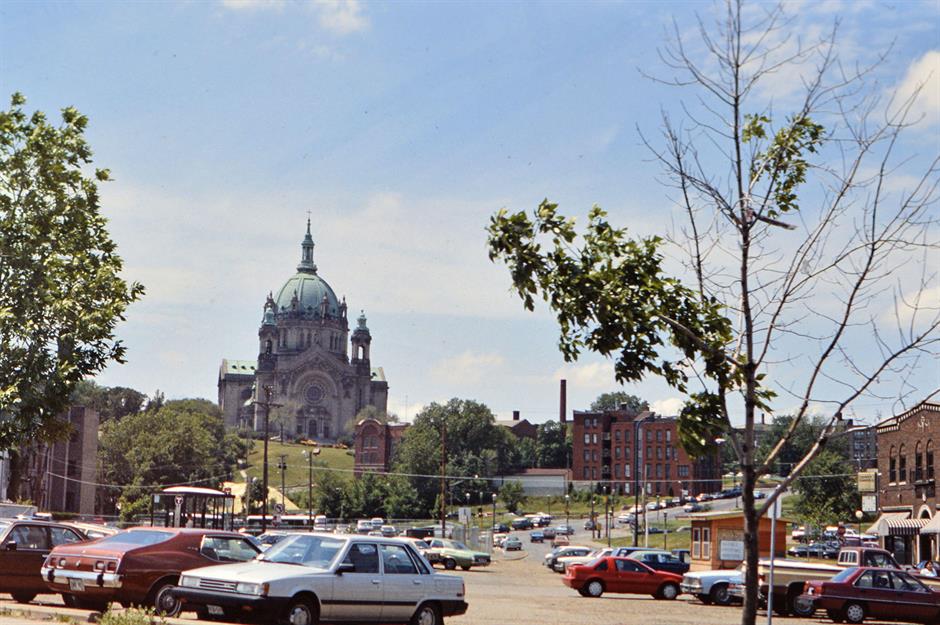
The year of 1987 was remarkable for the Cathedral of Saint Paul in Saint Paul, and not just because of the amount of parking spaces so close to the center of the city. Rather, it was the year that the USA’s most impressive Catholic cathedral got five new bells.
The large bronze bells were cast in France and replaced the original single bell which a former rector said was "not loud enough to scare a pigeon."
Mississippi: Alamo Plaza Restaurant Hotel Court, Jackson (1986)
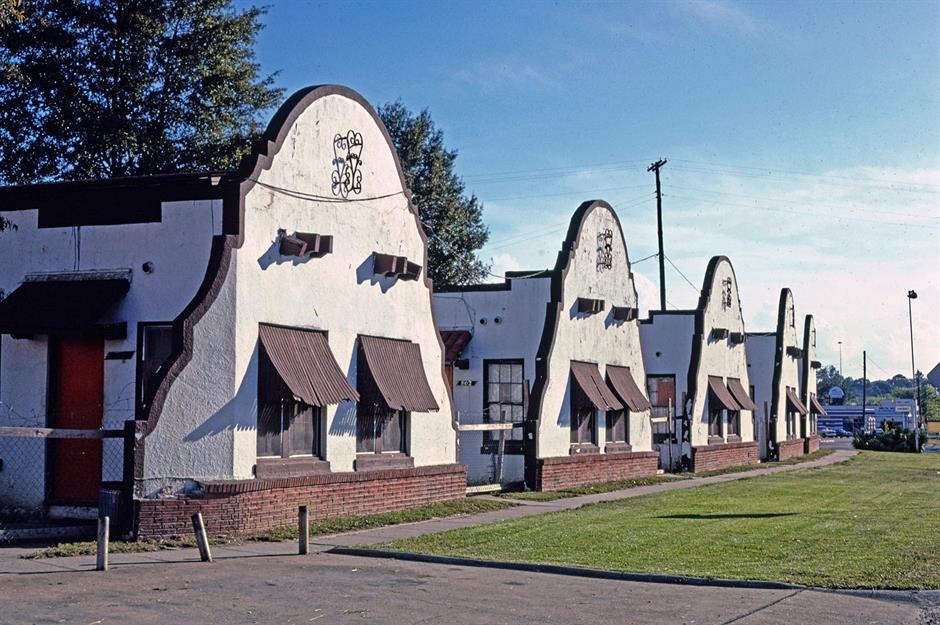
The Alamo Plaza chain of hotels began in Waco, Texas in 1929, based on the very simple concept of a façade that looked like the Alamo. Soon they were dotted all across the south, including this one on Highway 80 in Jackson.
The Alamo Plaza in Jackson was managed by a Mr. and Mrs. Jimmy Carter – sadly not of Presidential fame – and by the time this photo was taken in 1986 it had fallen upon hard times. It closed for good in 1988 and a year later it was demolished.
Kansas: Fiberglass bull, Kansas City (1987)
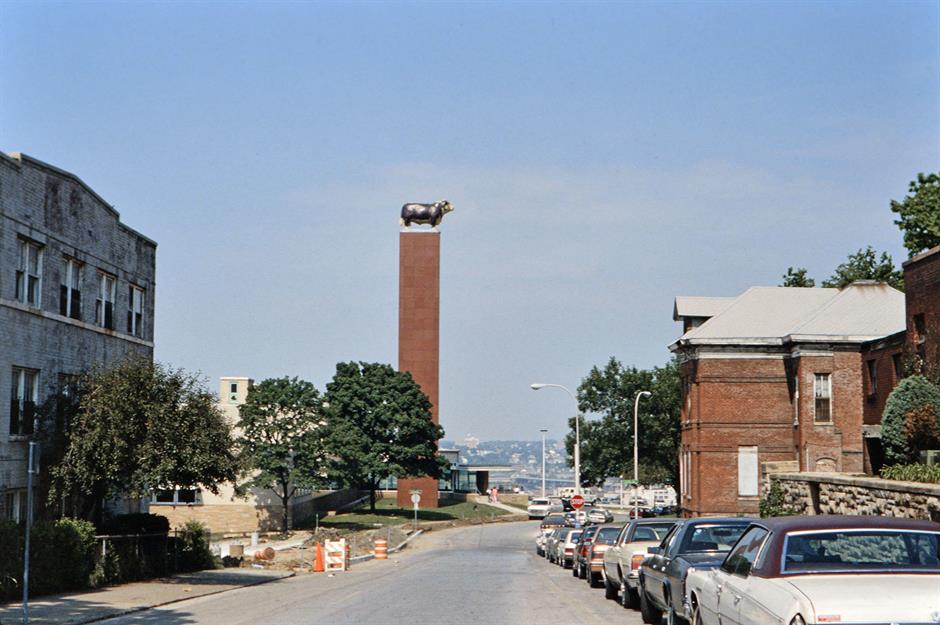
In 1953, President Dwight Eisenhower attended the dedication of the new national headquarters for the American Hereford Association in Kansas City. The following year, a 5,500-pound fiberglass Hereford bull was added, perched atop a 90-foot pylon, as seen here in 1987.
Quickly christened Bob (short for 'bull on building') the statue became a beloved city landmark. When the American Hereford Association relocated in 1997, Bob was put out to pasture on a new plinth in Mulkey Square Park.
Montana: Almosta Road (1986)
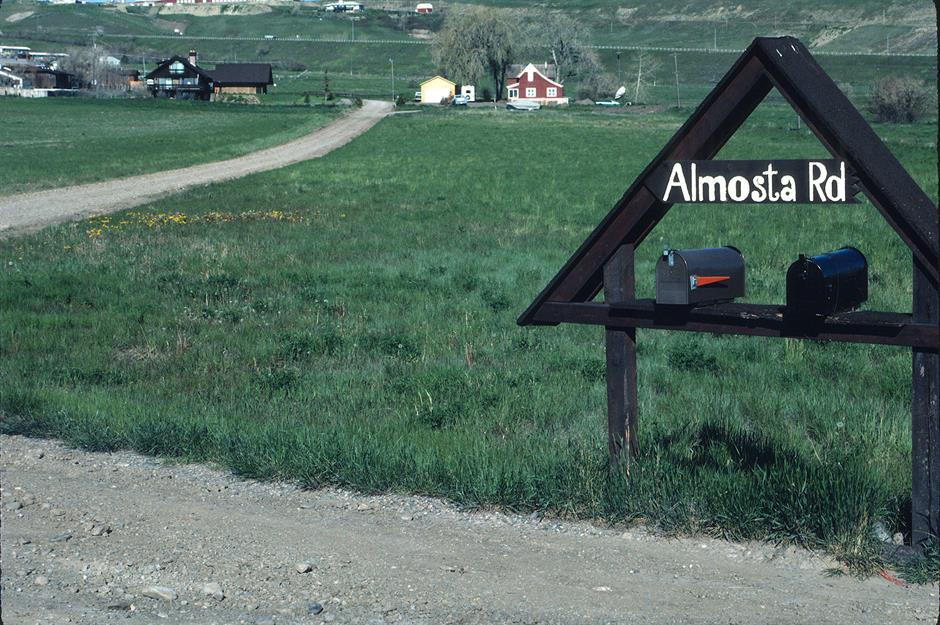
This tiny dirt road sits near Hauser Lake, northeast of Helena, the capital of Montana. Helena had humble beginnings, founded as a gold camp in 1864 during the Montana gold rush.
That gold rush saw Helena becoming a wealthy city, boasting 50 millionaires by 1888, the highest per capita of anywhere in the world at the time. That wealth still hadn’t trickled out to Almosta Road when this photo was taken nearly 100 years later.
Nebraska: Golden Spike Drive-In, Omaha (1980)
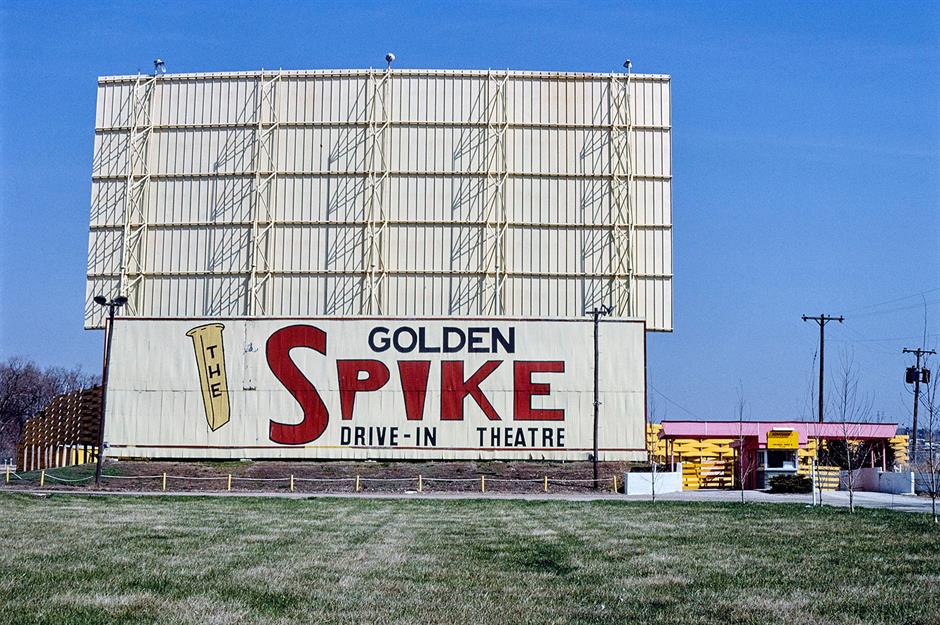
Video may well have killed the radio star in the 1980s, but it also sounded the death knell for drive-in movie theaters. Affordable VHS players and video rental stores like Blockbuster offering all the (near) latest releases meant that people began staying home to watch a movie.
Here we see Omaha’s iconic Golden Spike Drive-In, just four years before it closed for good in 1984. The last movie it played? The Revenge of the Nerds.
Nevada: Welcome to Reno (1989)
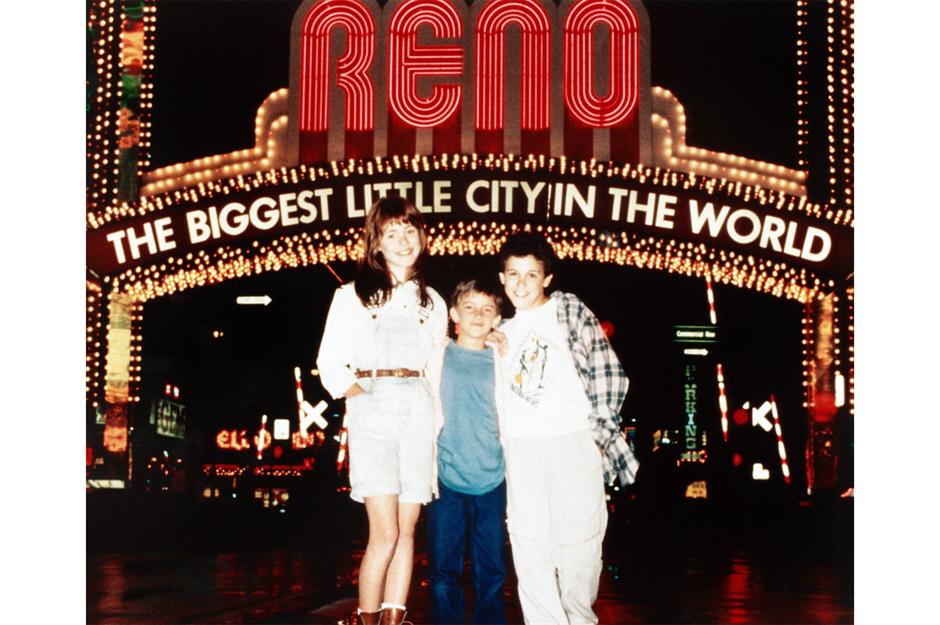
The Wizard is a 1989 adventure comedy that follows three kids hitchhiking across America to compete in a video game championship. Much of the movie was filmed in northern Nevada, including Reno.
Here we see three of the movie's young stars posing in front of the city’s famous welcome sign: Jenny Lewis (who later formed the band Rilo Kiley), Luke Edwards, and Fred Savage, known for The Wonder Years. The movie also marked the acting debut of future Spider-Man, Tobey Maguire.
New Hampshire: Story Land, Glen (1984)
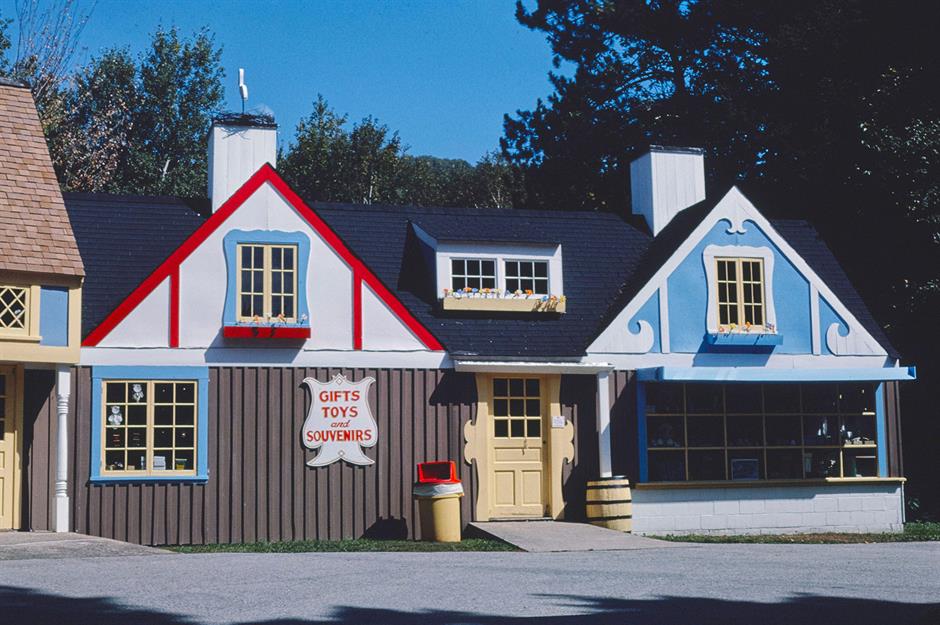
The venerable Story Land amusement park in Glen, New Hampshire, opened in 1954 with a simple aim: to create a magical place where storybook characters could come to life. Seventy years later, it is still going strong.
When this photo was taken in 1984, three decades after it opened, Story Land was in the midst of significant growth, adding new rides and attractions including Pirate Ship, Alice’s Tea Cups, and Voyage to the Moon.
New Jersey: Caesars Atlantic City Hotel & Casino (1985)

Caesars Hotel and Casino opened on June 26, 1979, the second casino in Atlantic City and one of the first few outside of Las Vegas. Like its namesake in Vegas, its décor followed an ancient Greek and Roman theme.
When this photo was taken in 1985, it had just undergone a massive expansion with the opening of the Circus Maximus Showroom, a grand entertainment complex that replaced the much smaller Cabaret Theater.
New Mexico: White Sands Missile Park (1983)
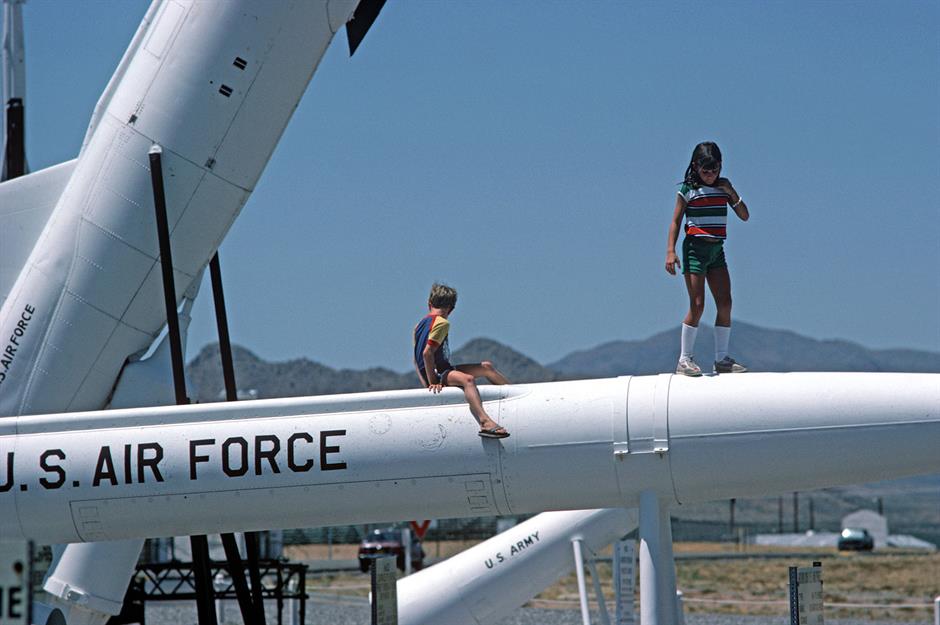
The White Sands Missile Range in La Cruces, New Mexico, is regarded as the ‘birthplace of America's missile and space activity’ and one of the key locations of the Manhattan Project.
And a great place, it would seem from this photo taken in 1983, to play on a decommissioned intercontinental missile. Since then the missiles have been arranged more purposefully as part of the White Sands Missile Range Museum, opened in 1994 to preserve and exhibit artifacts from this extraordinary period of America’s military history.
New York: Times Square (1986)
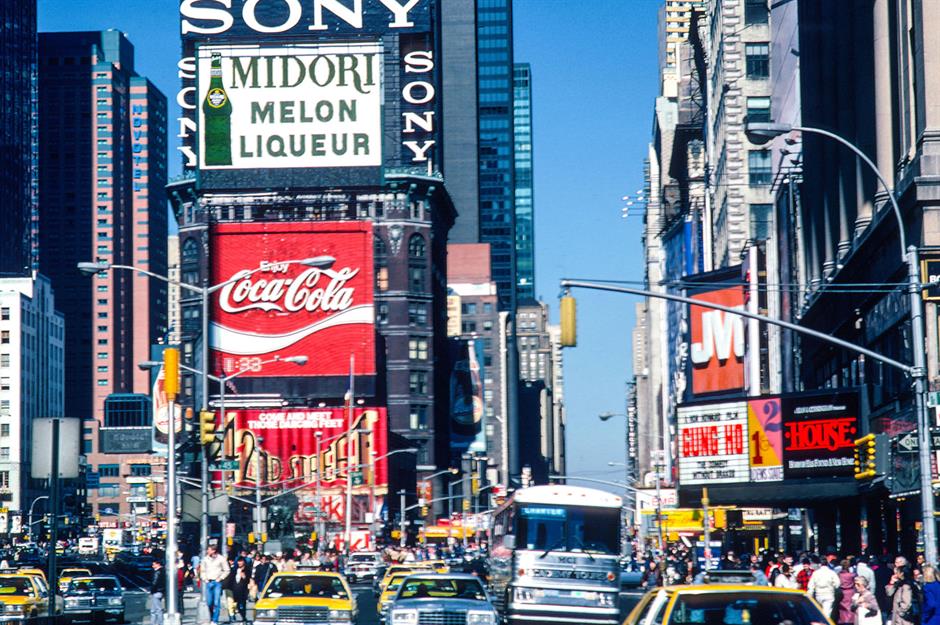
In 1981, Rolling Stone magazine described New York City’s famous Times Square as the ‘sleaziest block in America.’ When this photo was taken five years later, little had changed.
In the shadow of the square’s dazzling neon signs you’d find pornographic cinemas, sex shops, and one of the highest crime rates in the city. It wasn't until the 1990s that Mayor Rudolph Giuliani initiated a project to clean up the area.
North Carolina: Curbside service, Charlotte (1982)
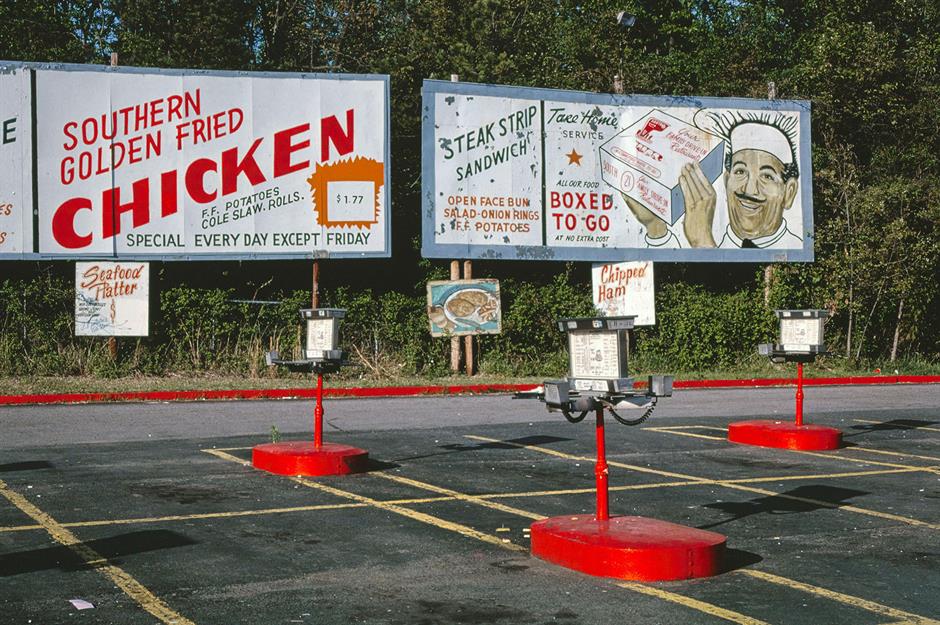
The South 21 Drive-In restaurant in Charlotte, North Carolina, was opened by three Greek brothers in the 1950s and quickly became a hit. Locals couldn’t get enough of the onion rings and 'Super Boy' double hamburgers, ordered from individual posts and brought directly to your car.
Times were tough in the 1980s, when this photo was taken, as the likes of McDonalds and Taco Bell began offering drive-thru service. But South 21 prevailed and continues to operate to this day.
North Dakota: The Mighty Og, Mandan (1980)
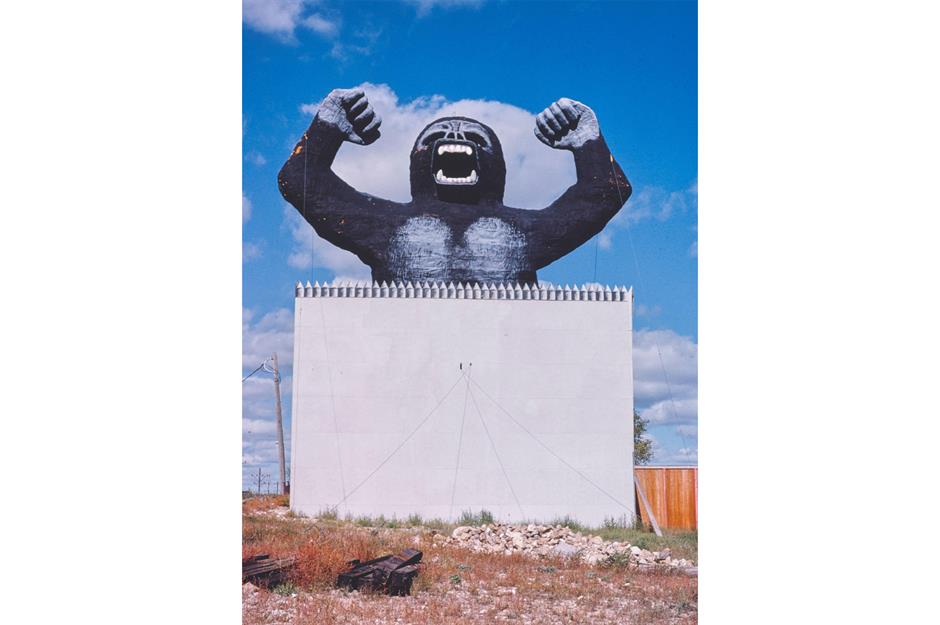
Those driving along Interstate 94 in Mandan, North Dakota, in the 1980s would be hard pressed to miss the Mighty Og, a giant mechanical gorilla that loomed over Rawhide City, an indoor Old West theme park.
Local residents weren’t particularly happy about Og. They couldn’t see a link with North Dakota or even the Old West. But when Rawhide City closed and Og moved on in 1993 there was genuine sadness.
Ohio: Airstream Trailer Rally, Jackson Center (1983)
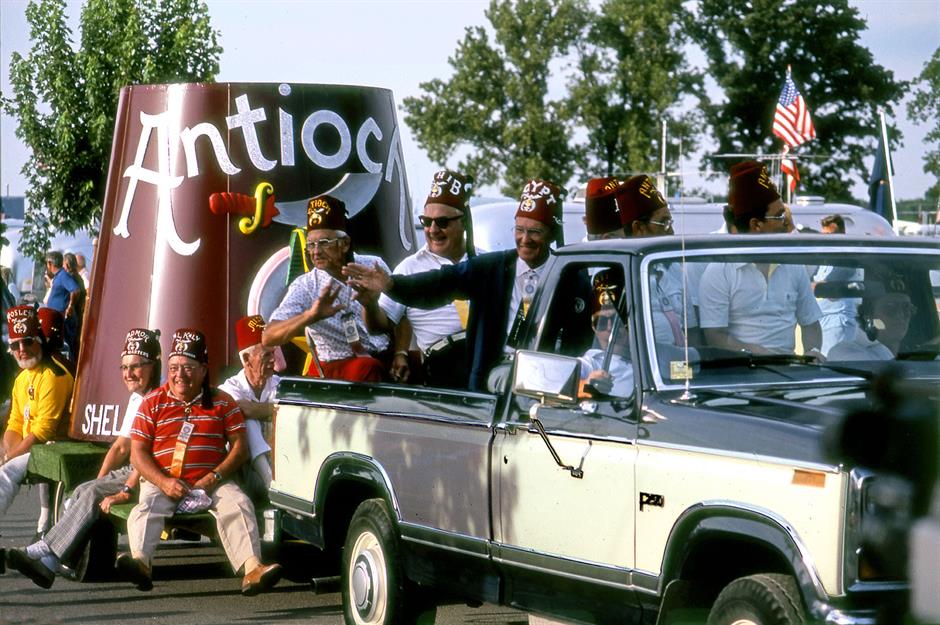
The iconic Airstream aluminum trailers have been built in Jackson Center, Ohio, since 1952 and the city has celebrated with a parade through town on and off ever since.
Here we see the 1983 rally, with owners from the Antioch Airstream club proudly wearing fezzes. More recently the parade has become affectionately known as ‘Alumapalooza.’
Oklahoma: Honoring code talkers, Oklahoma City (1989)
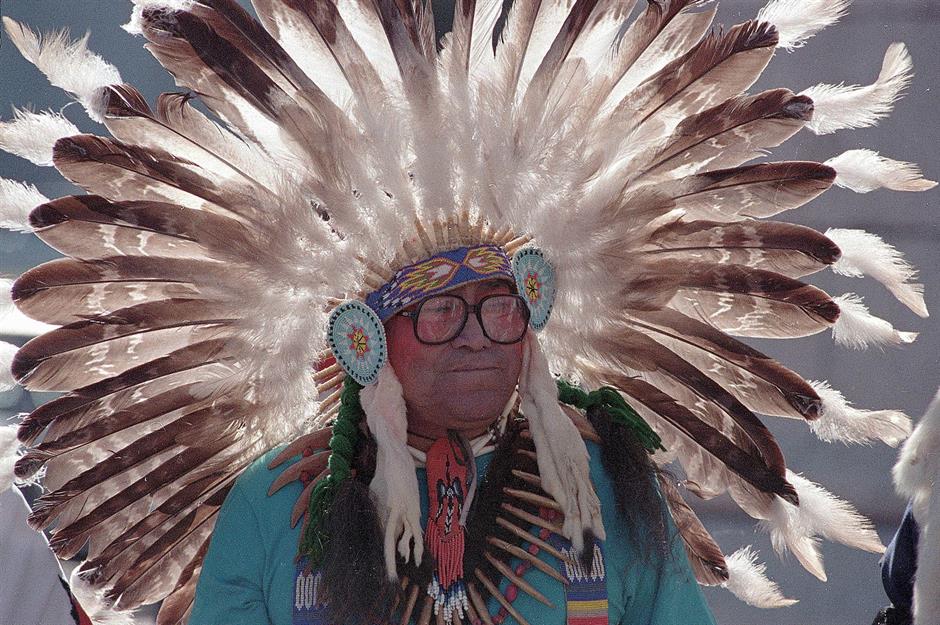
During both the World Wars, Native American soldiers used their tribal language to send secret communications on the battlefield. Known as Code Talkers, they quite literally changed the course of both wars.
In November 1989, the French government held a ceremony in Oklahoma City to honor the service of three surviving Comanche code talkers with the Chevalier de l'Ordre National du Merite (Knight of the National Order of Merit). Here we see Comanche medicine man George Woogee Watchetaker taking part in the ceremony.
Oregon: Bomber gas station, Milwaukie (1980)
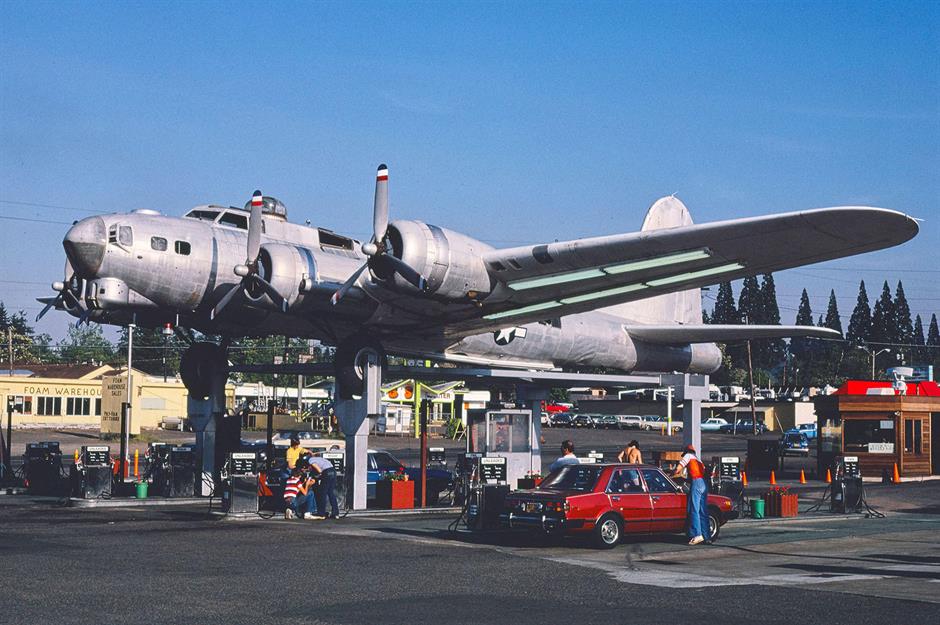
When Art Lacey came up with the idea of buying a decommissioned B-17 bomber as an attraction for his gas station in Milwaukie, Oregon in 1947, his friend bet him $5 it couldn’t be done.
This photo from 1980 shows that he had to pay up. By this time everything that wasn’t bolted down on the plane had been stolen, and the doors welded shut after a young boy fell out of it in the late 1950s, and his parents initiated a lawsuit.
Pennsylvania: Pittsburgh skyline (1980)
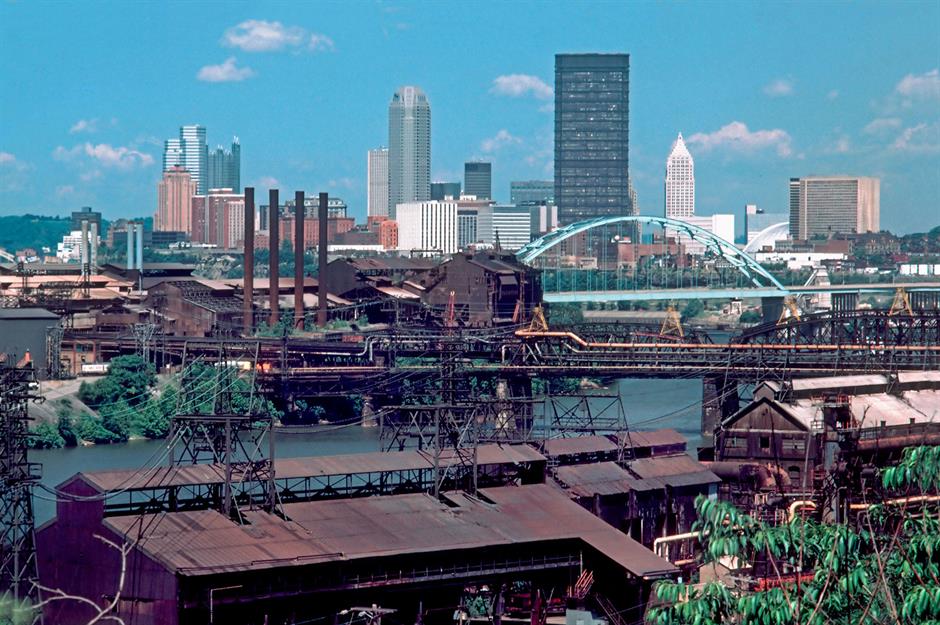
In the 1980s, Pennsylvania’s second biggest city hit hard times. Its once mighty steel industry began to collapse, leading to widespread job losses, factory closures, and a dramatic population decrease.
Despite these challenges, the city also experienced cultural and civic revitalization with the Children's Museum of Pittsburgh opening and the Benedum Center for the Performing Arts reopening. In 1985, it was even named 'America's Most Liveable City' by Rand McNally.
Rhode Island: Vose Florist, Cumberland (1984)
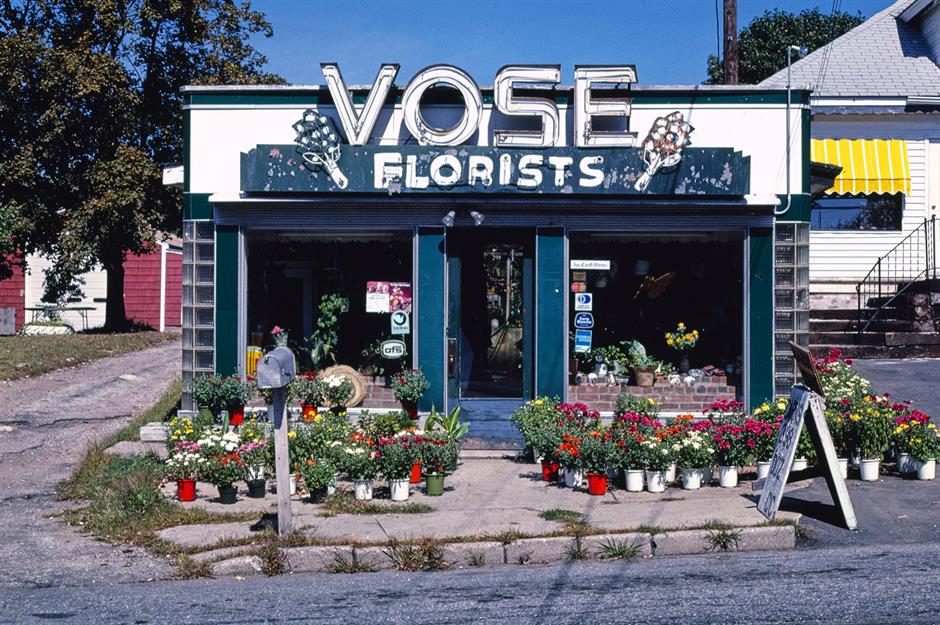
Quaint Cumberland in Providence County is replete with Rhode Island charm. The current local mayor, Jeff Mutter, will tell you that the greatest thing about Cumberland isn’t a thing at all – it’s the people.
This photo of the local florist, taken in 1984, seems to capture that spirit perfectly. But at the same time, the nearby Diamond Hill ski area had already closed after years of financial difficulty, and a paroled bank robber had opened fire on police two years earlier, killing a young woman and injuring two officers.
South Carolina: Cypress Gardens, Moncks Corner (1987)
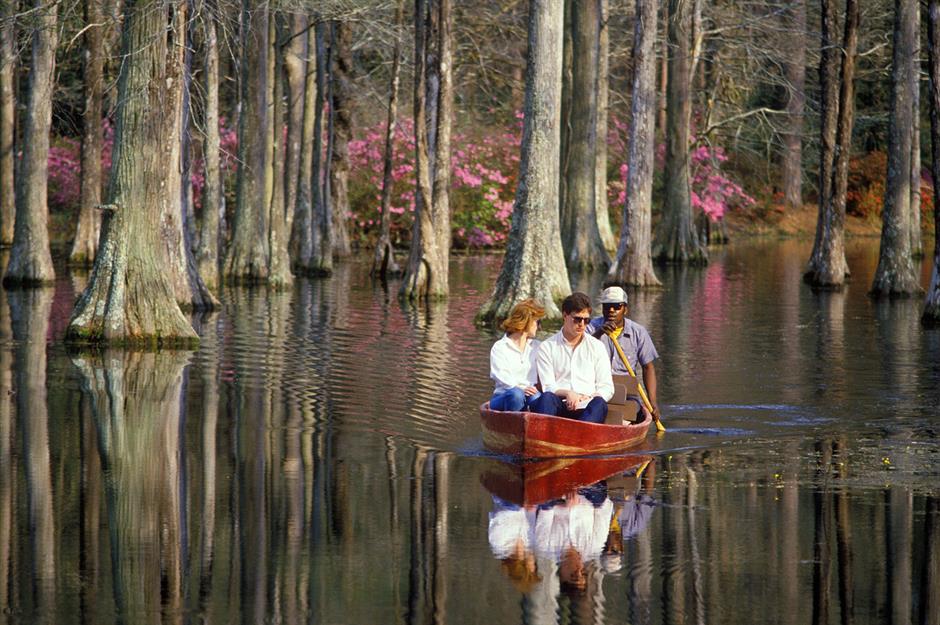
Cypress Gardens began life as part of a rice plantation established in the 18th century. In 1909, it was transformed into a duck hunting preserve and garden, and later opened to the public in 1932. In 1963, the property was donated to the City of Charleston.
Here we see tourists exploring the garden’s famous blackwater swamp in 1987. The eerie, atmospheric waters have featured in films such as The Patriot, North and South, and Cold Mountain.
South Dakota: Dinosaur Park, Rapid City (1987)
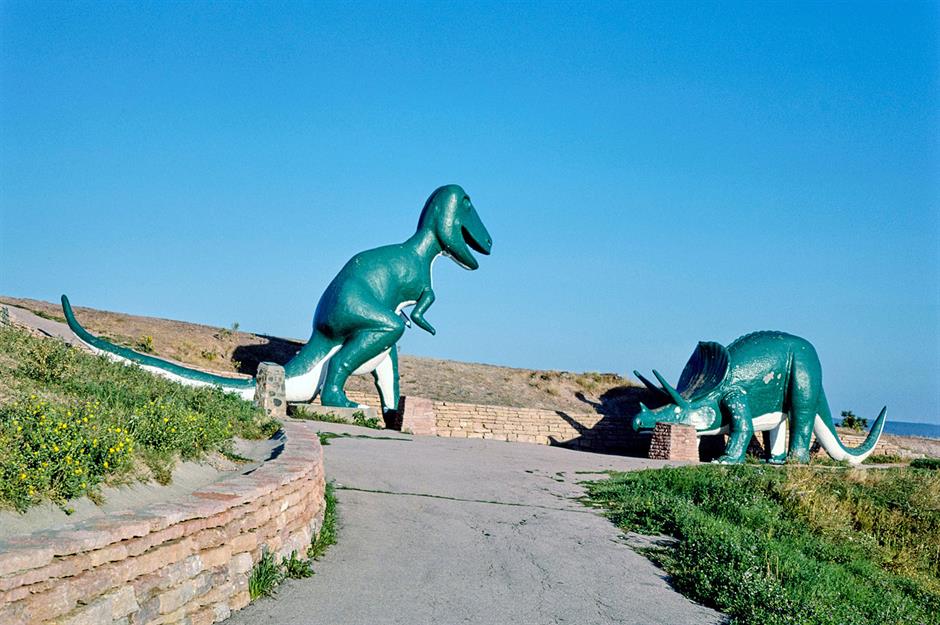
The seven life-sized dinosaur sculptures that dot the hills overlooking Rapid City, South Dakota, were created as part of a Works Progress Administration project during the Great Depression, intended to provide jobs for locals.
They were also meant to attract tourists passing through on their way to Mount Rushmore. While the dinosaurs themselves are concrete models, their presence nods to the region’s rich fossil history – South Dakota has yielded remains of species like Tyrannosaurus rex and Triceratops, both pictured here in 1987.
Tennessee: Graceland 10 years after Elvis died (1987)
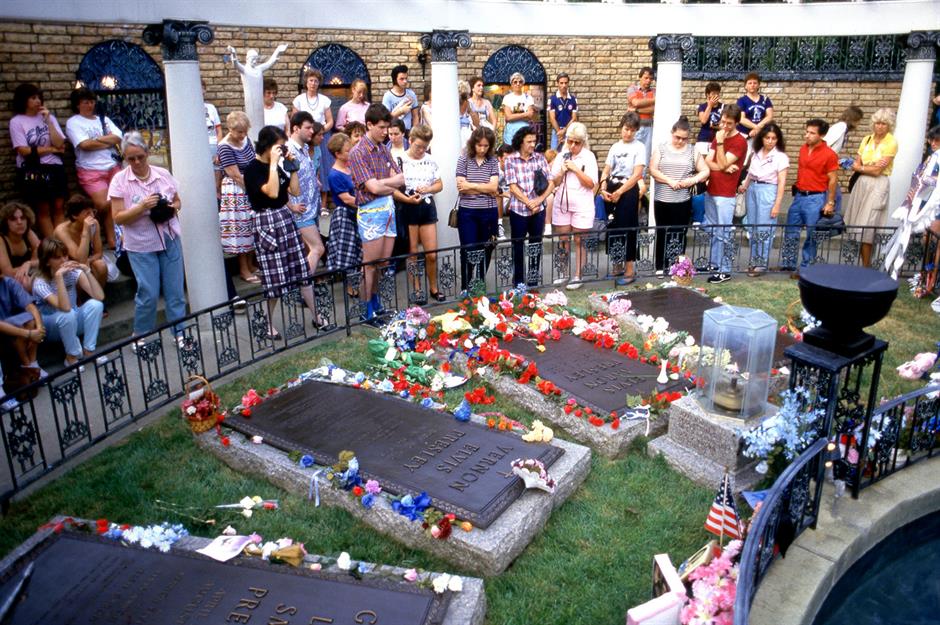
Legendary American rocker Elvis Presley died on August 16, 1977. However, it wasn't until June 7, 1982, that his famous home, Graceland, was opened to the public. On that day, over 3,000 fans from around the world paid $5 to enter the hallowed gates.
This photo was taken on the 10th anniversary of Elvis’s death in 1987, with stricken fans lining up to pay their respects at his gravesite.
Texas: the cast of Dallas, Southfork Ranch (c.1980s)
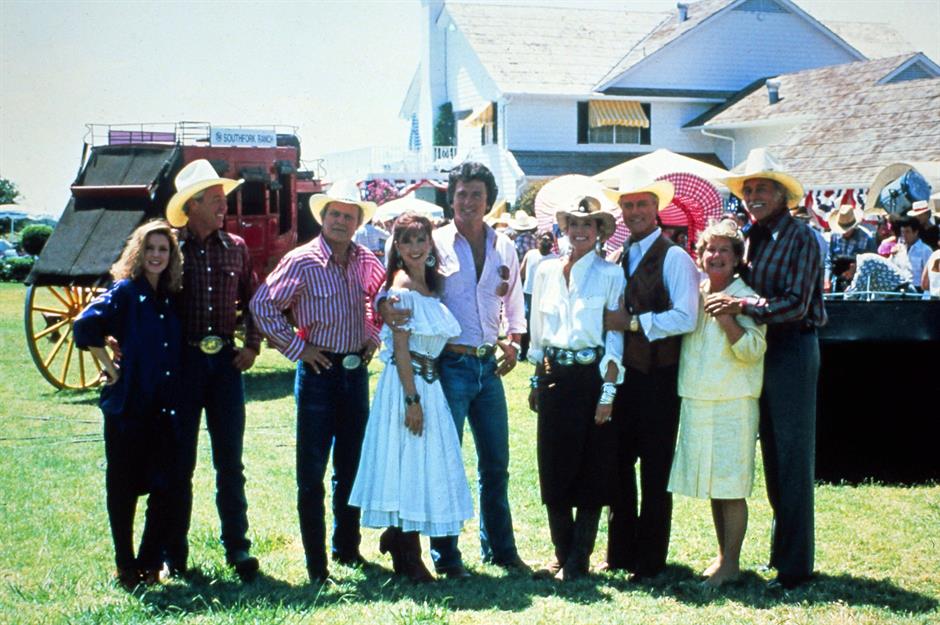
Big hair. Big shoulder pads. And big drama. Nothing encapsulated the excesses of the 1980s more than the TV series Dallas. Shot in Texas and watched all over the world, the lives, loves, and ruthless business dealings of JR, Sue Ellen, Bobby, and all the other lesser Ewings captured the imagination of viewers in 130 countries.
Here we see the cast posing in front of Southfork Ranch, the real-life property north of Dallas where the series was shot.
Utah: Navajo shepherds, Monument Valley (1986)
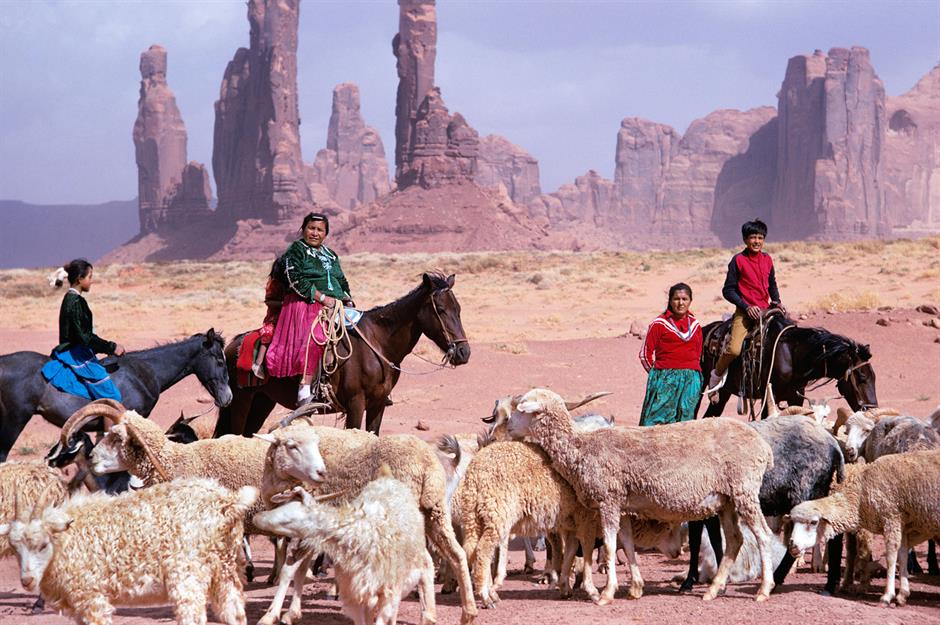
Sheep herding has long been a deeply rooted cultural tradition among the Navajo, particularly in the Monument Valley region – even before the days of the 19th-century shepherd and sage, Wolfkiller.
These Navajo shepherds, photographed in 1986, would have relied on their flocks for both meat and wool, the latter essential for traditional rug weaving. While the practice had declined by the turn of the new millennium, recent efforts have sought to revive this vital aspect of Navajo life.
Vermont: Rainbow over East Corinth (1986)
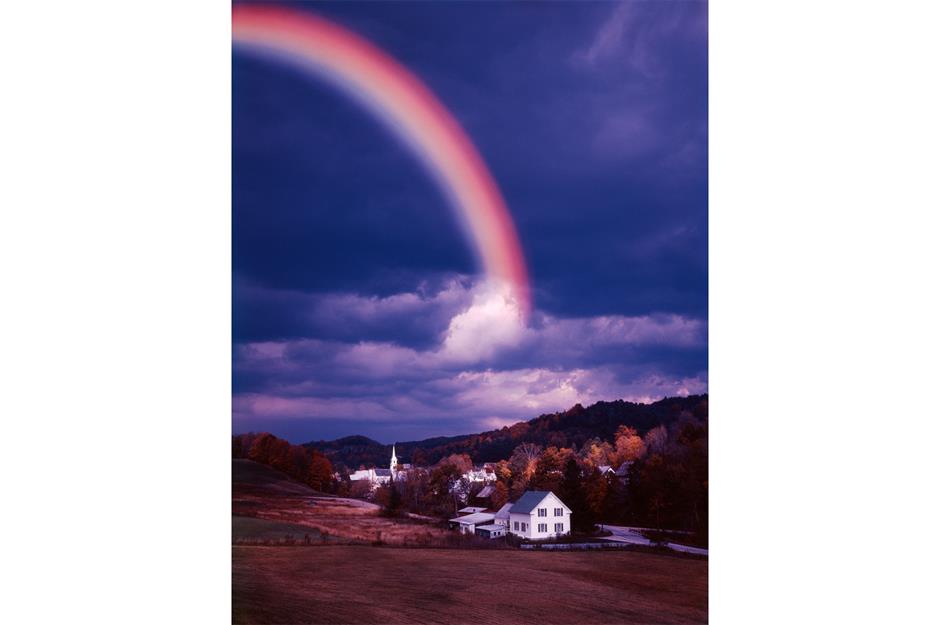
If this rainbow over the town of East Corinth, Vermont, in 1986 looks otherworldly, consider it something of a premonition. Just a year or so later Tim Burton would be in town, shooting his iconic horror-comedy film, Beetlejuice.
The cast and crew returned again in the summer of 2023 to shoot the sequel, Beetlejuice, Beetlejuice, recreating many of the original film’s locations.
Virginia: Don’s Trading Post, Christiansburg (1982)
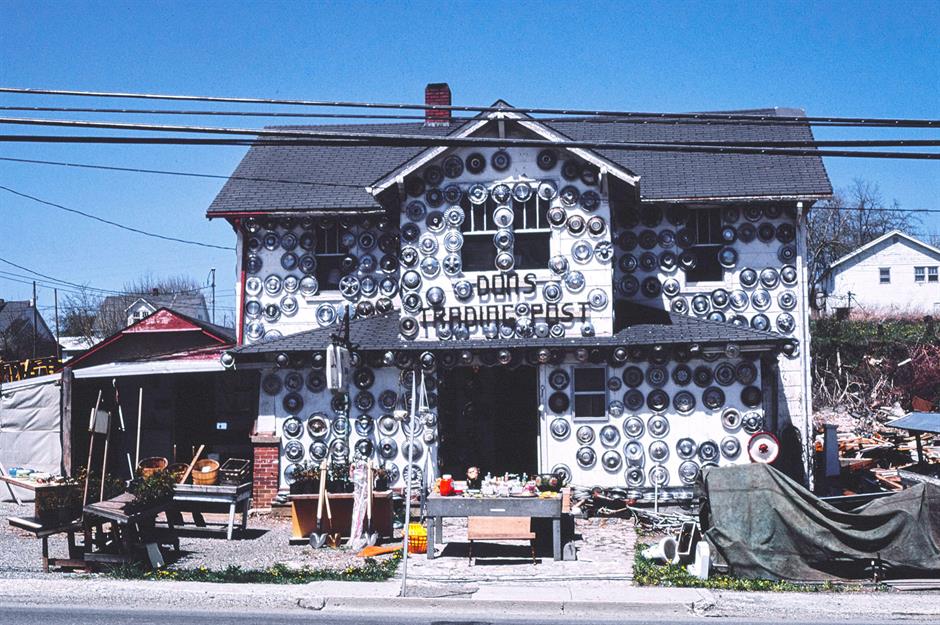
Not much is known about Don’s Trading Post in Christiansburg, Virginia. A recent Facebook post suggests that Don was the local bus driver, which may or may not explain his obvious penchant for hub caps.
The photo itself was taken by John Margolies in 1982 as part of the Library of Congress's Roadside America collection.
Washington: Aquarium street food, Seattle (1983)
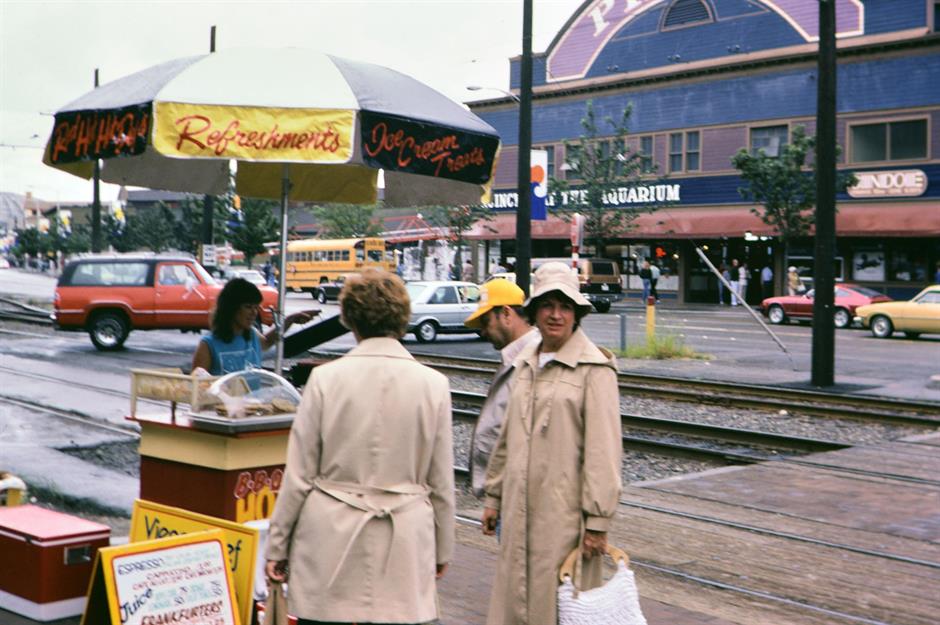
Seattle’s world famous aquarium can be found on Pier 59, set in the old Ainsworth & Dunn Pike Street Wharf. Its website describes the aquarium as ‘a warm, bright and vibrant underwater world teeming with life.’
Which begs the question as to why these people were outside in the city’s notorious drizzle in 1983. They must have been some hot dogs.
West Virginia: Public bus, Charleston (1985)

The 1980s saw the beginning of downtown revitalization efforts in Charleston. The most notable project was the Charleston Town Center mall, a $100 million showpiece with a three-story waterfall and the largest downtown-based shopping mall east of the Mississippi River.
The local Kanawha Valley Regional Transportation Authority (KRT) buses, pictured here in 1985, played a vital role in connecting the city center with its surrounding communities.
Wisconsin: Ice boat race, Sturgeon Bay (1982)
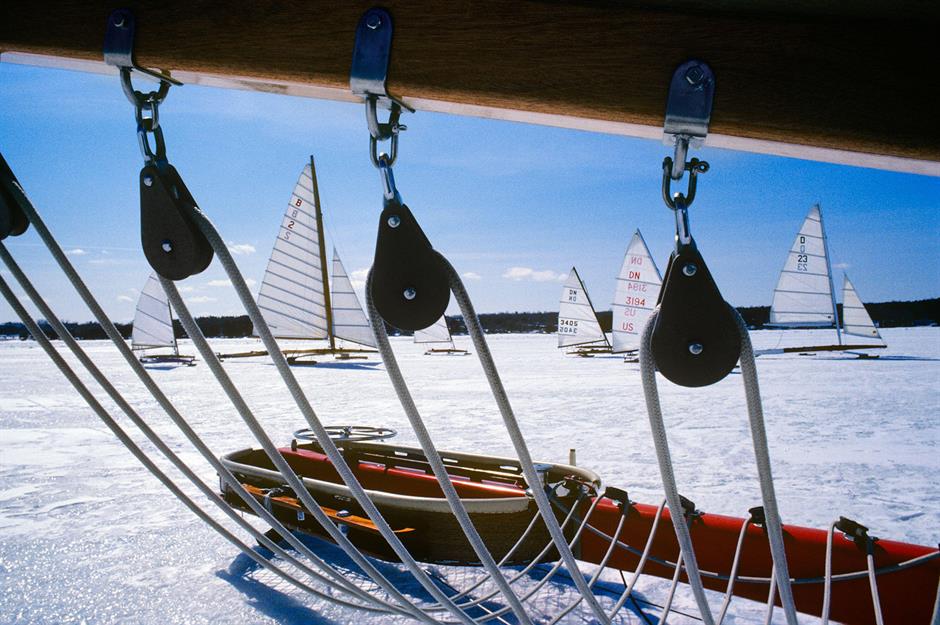
Ice boating old-timers in Sturgeon Bay, Door County may be bemoaning the decline of the sport and the lack of young blood coming through, but back when this photo was taken in 1983, the sport was booming.
On days like the one depicted, it’s not hard to see why. Blue skies, pure white ice, and just a hint of the 15 miles per hour winds the bay was famous for.
Wyoming: Watching Old Faithful, Yellowstone National Park (1982)
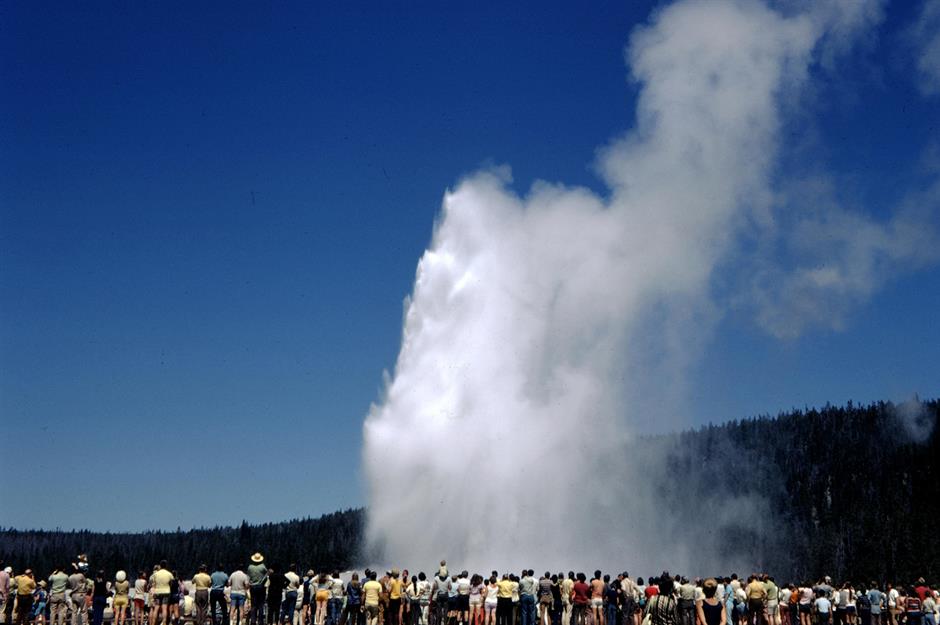
In the 1980s, researchers sought to gain a better understanding of Yellowstone’s famous geyser, Old Faithful, by using probes to measure temperature and pressure within the geyser's vent.
The temperature sensors recorded wild fluctuations, reflecting the volatile nature of the geyser. Not volatile enough, though, to insist visitors like these ones in 1982, step a little further back from Old Faithful’s erratic geothermal area.
Comments
Do you want to comment on this article? You need to be signed in for this feature